Vol. 71, No. 21 (2022)
2022-11-05
SPECIAL TOPIC—Physical electronics for brain-inspired computing
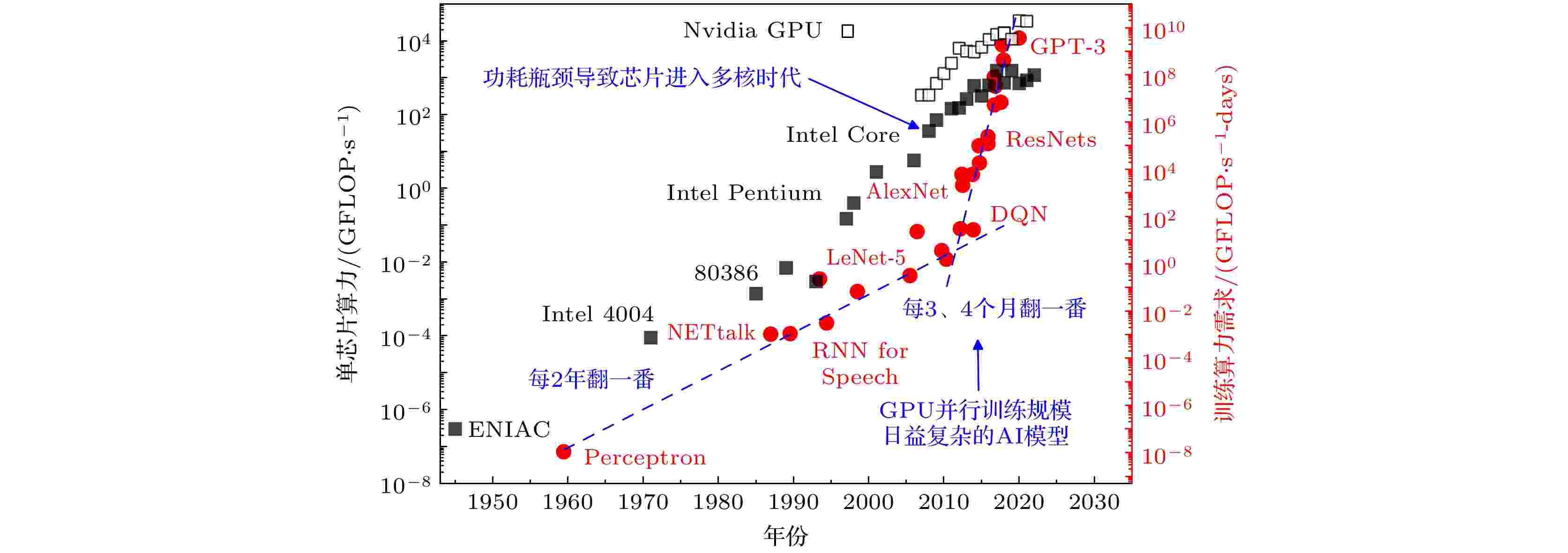
EDITOR'S SUGGESTION
2022, 71 (21): 210702.
doi: 10.7498/aps.71.20220974
Abstract +
A neuromorphic chip is an emerging AI chip. The neuromorphic chip is based on non-Von Neumann architecture, and it simulates the structure and working principle of the human brain. Compared with non-Von Neumann architecture AI chips, the neuromorphic chips have significant improvement of efficiency and energy consumption advantages. The 3D-NAND flash memory has the merits of a mature process and ultra-high storage density, and recently it attracted many researchers’ attention. However, owing to the proprietary nature of the technology, there are few hardware implementations. This paper reviews the present research status of neuromorphic computing by using the 3D-NAND flash memory, introduces the forward propagation and backward propagation schemes, and proposes several improvements on the device, structure, and architecture of 3D NAND for neuromorphic computing.
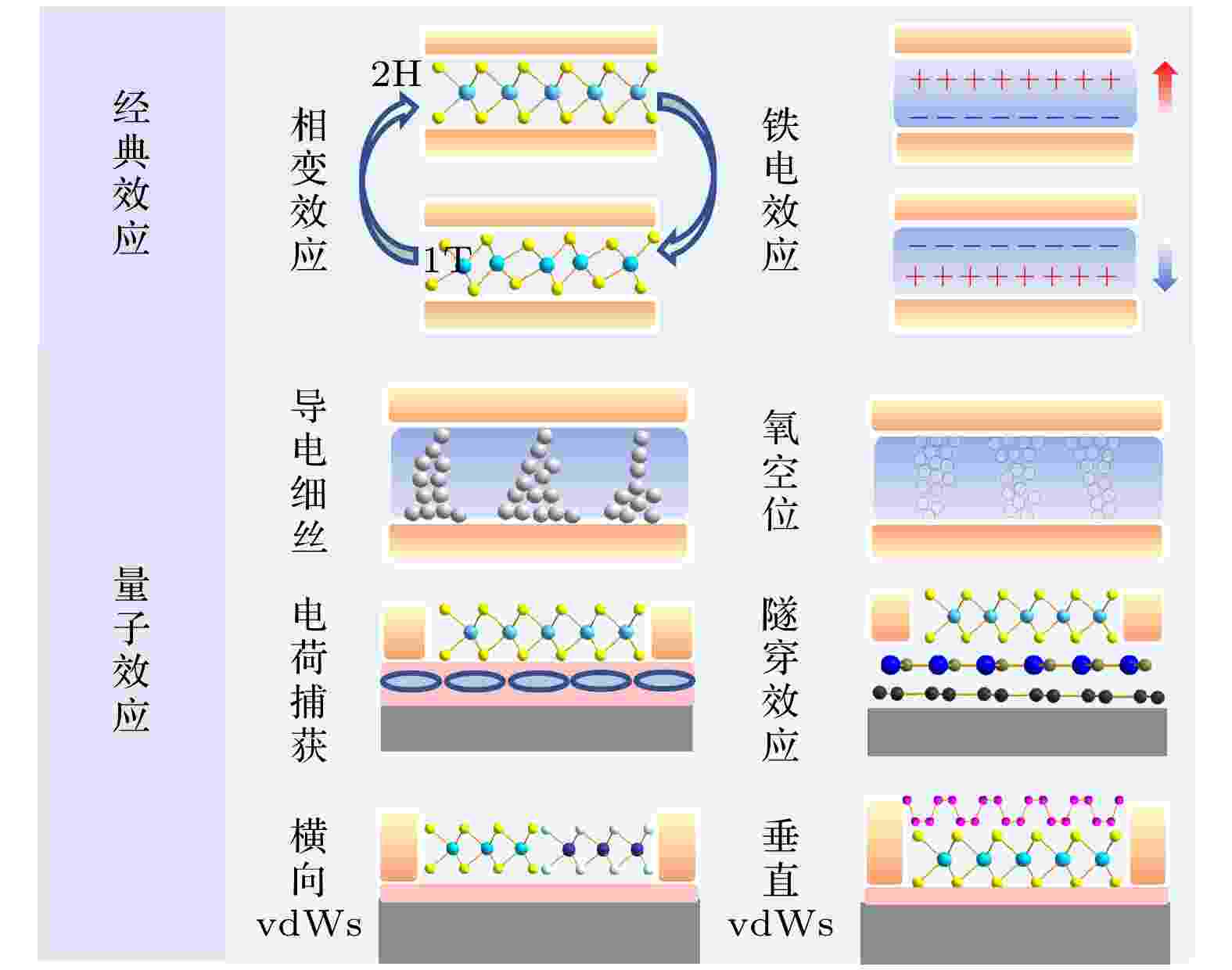
EDITOR'S SUGGESTION
2022, 71 (21): 218504.
doi: 10.7498/aps.71.20221424
Abstract +
In recent years, the development of artificial intelligence has increased the demand for computing and storage. However, the slowing down of Moore’s law and the separation between computing and storage units in traditional von Neumann architectures result in the increase of power consumption and time delays in the transport of abundant data, raising more and more challenges for integrated circuit and chip design. It is urgent for us to develop new computing paradigms to meet this challenge. The neuromorphic devices based on the in-memory computing architecture can overcome the traditional von Neumann architecture by Ohm’s law and Kirchhoff’s current law. By adjusting the resistance value of the memristor, the artificial neural network which can mimic the biological brain will be realized, and complex signal processing such as image recognition, pattern classification and decision determining can be carried out. In order to further reduce the size of device and realize the integration of sensing, memory and computing, two-dimensional materials can provide a potential solution due to their ultrathin thickness and rich physical effects. In this paper, we review the physical effects and memristive properties of neuromorphic devices based on two-dimensional materials, and describe the synaptic plasticity of neuromorphic devices based on leaky integrate and fire model and Hodgkin-Huxley model in detail, including long-term synaptic plasticity, short-term synaptic plasticity, spiking-time-dependent plasticity and spiking-rate-dependent plasticity. Moreover, the potential applications of two-dimensional materials based neuromorphic devices in the fields of vision, audition and tactile are introduced. Finally, we summarize the current issues on two-dimensional materials based neuromorphic computing and give the prospects for their future applications.
REVIEW
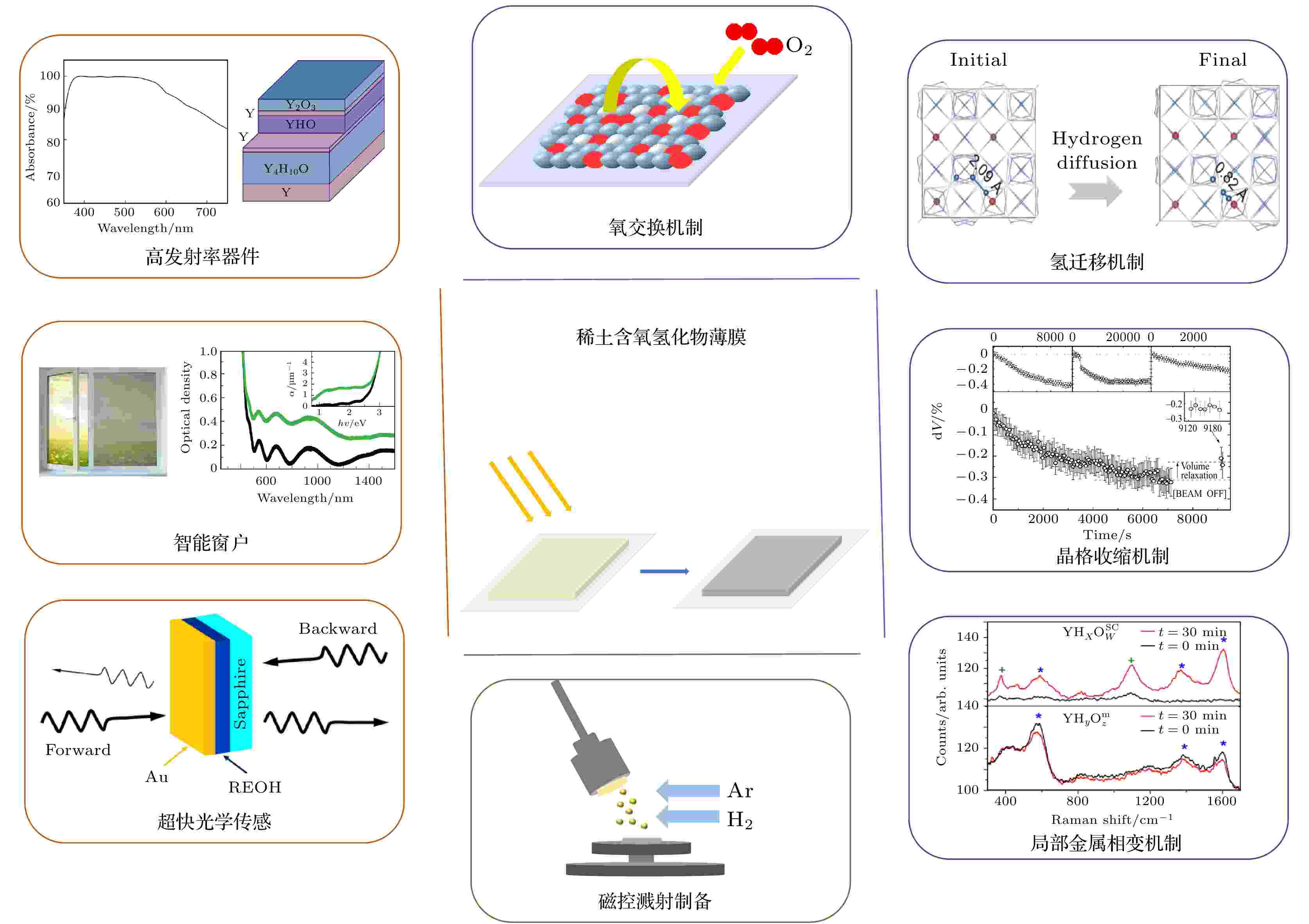
2022, 71 (21): 218101.
doi: 10.7498/aps.71.20221046
Abstract +
Photochromic material, as an adaptive smart material, has a wide range of applications in smart windows, photoelectric sensors, optical storage, etc. Oxygen-containing rare-earth metal hydride (REHxOy) film, a new type of photochromic material, has attracted the attention of researchers for its efficient and reversible color-changing properties, simple and reproducible preparation methods, and fast darkening-bleaching time. In this paper we review the current research status of structural composition, color change mechanism, and property modulation of oxygen-containing rare-earth metal hydride films. Exposure to visible light and ultraviolet (UV) light can lead the optical transmission of visible and infrared (IR) light to degrade. The photochromic mechanisms can be grouped into four mechanisms: lattice contraction mechanism, oxygen exchange mechanism, local metal phase change, and hydrogen migration mechanism. Currently, performance can be tuned by controlling film morphology, designing chemical components, improving substrate adaptation, multilayer film structure design, etc. Finally, the future research focus of thin film is prospected.
GENERAL
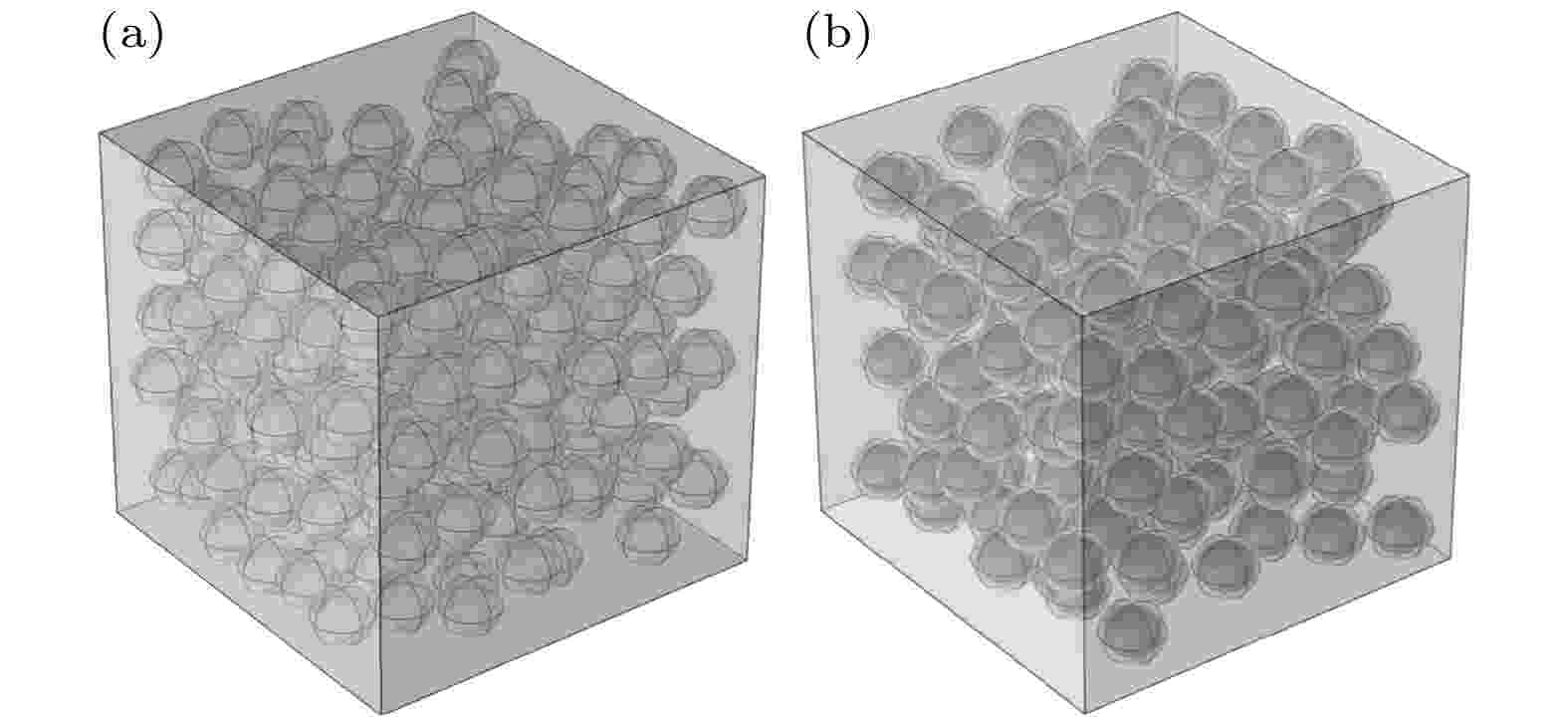
2022, 71 (21): 210201.
doi: 10.7498/aps.71.20220839
Abstract +
Coefficient of thermal expansion (CTE) and dielectric constant for the SiO2/polytetrafluoroethylene (SiO2/PTFE) dielectric composite are mainly influenced by their filling content, and how to accurately predict the effect is still a great challenge untill now. In this work, the CTE and dielectric constant of SiO2/PTFE dielectric composite are systematically investigated by numerical simulation. The results show that with the increase of SiO2 content, CTE of SiO2/PTFE dielectric composite decreases, and the dielectric constant increases, which are in good agreement with the data reported in the literature (Han K K, Zhou J, Li Q Z, Shen J, Qi Y Y, Yao X P, Chen W 2020 J. Mater. Sci. Mater. Electron. 31 9196 ). The 30% (volume fraction) solid SiO2 sphere (SSS)/PTFE dielectric composite is the smallest CTE of 7.5×10–5 K–1, while 10% (volume fraction) hollow solid sphere (HSS)/PTFE possesses the smallest dielectric constant of 2.06. The CTE of SiO2/PTFE dielectric composite may decrease when the SiO2 distribution is dense at the bottom. The large aspect ratio of SiO2 filler may reduce CTEx of SiO2/PTFE dielectric composite. The molding parameters have little effect on the thermal expansion coefficient of the solid SiO2/PTFE composite dielectric material. This work provides a clear insight into the controlling of CTE and dielectric constant of SiO2/PTFE dielectric composite by adjusting its microstructure.
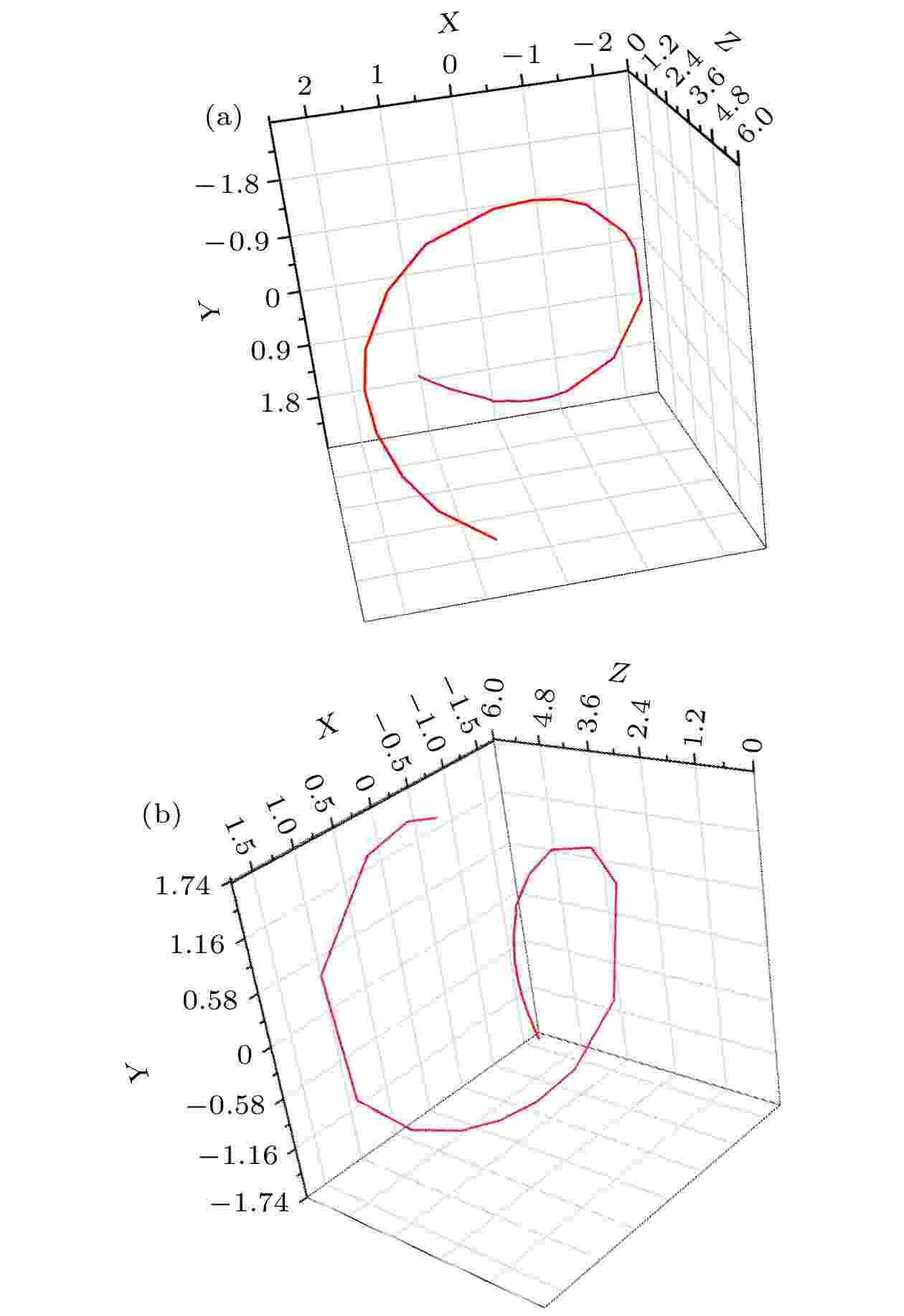
2022, 71 (21): 210301.
doi: 10.7498/aps.71.20220751
Abstract +
There exists an electron vortex solution with orbital angular momentum quantum in a non-spin-orbit coupling system which has nonconservative orbital angular momentum. We discuss the system with spin-orbit coupling and nonconservative orbital angular momentum, and we can find that the electrons with the total angular momentum numbers also have vortex beam solutions. And the vortex beam is expressed as an entangled wave function of the spin wave function and the vortex wave function. Taking the electrons in the central force field for example, in this paper constructed is a spinor vortex structure which is caused by the propagation of electrons carrying a fixed quantum number of total angular momentum along the z-axis. The spinor vortex structure is under the condition that the orbital angular momentum caused by spin-orbit coupling is non-conserved but the total angular momentum is conserved. The corresponding electron vortex beams in spin-vortex entanglement are solved by perturbation method, and the Foldy-Wouthuysen transformation is utilized to show that the vortex solution of the four-component spinor does exist in the case of relativity, when the electron with a fixed total angular momentum quantum number propagates along the z-axis in the central force field. The spinor provides theoretical support for the existence of the vortex structure for the system where the orbital angular momentum is not conserved but the total angular momentum is conserved due to spin-orbit coupling.
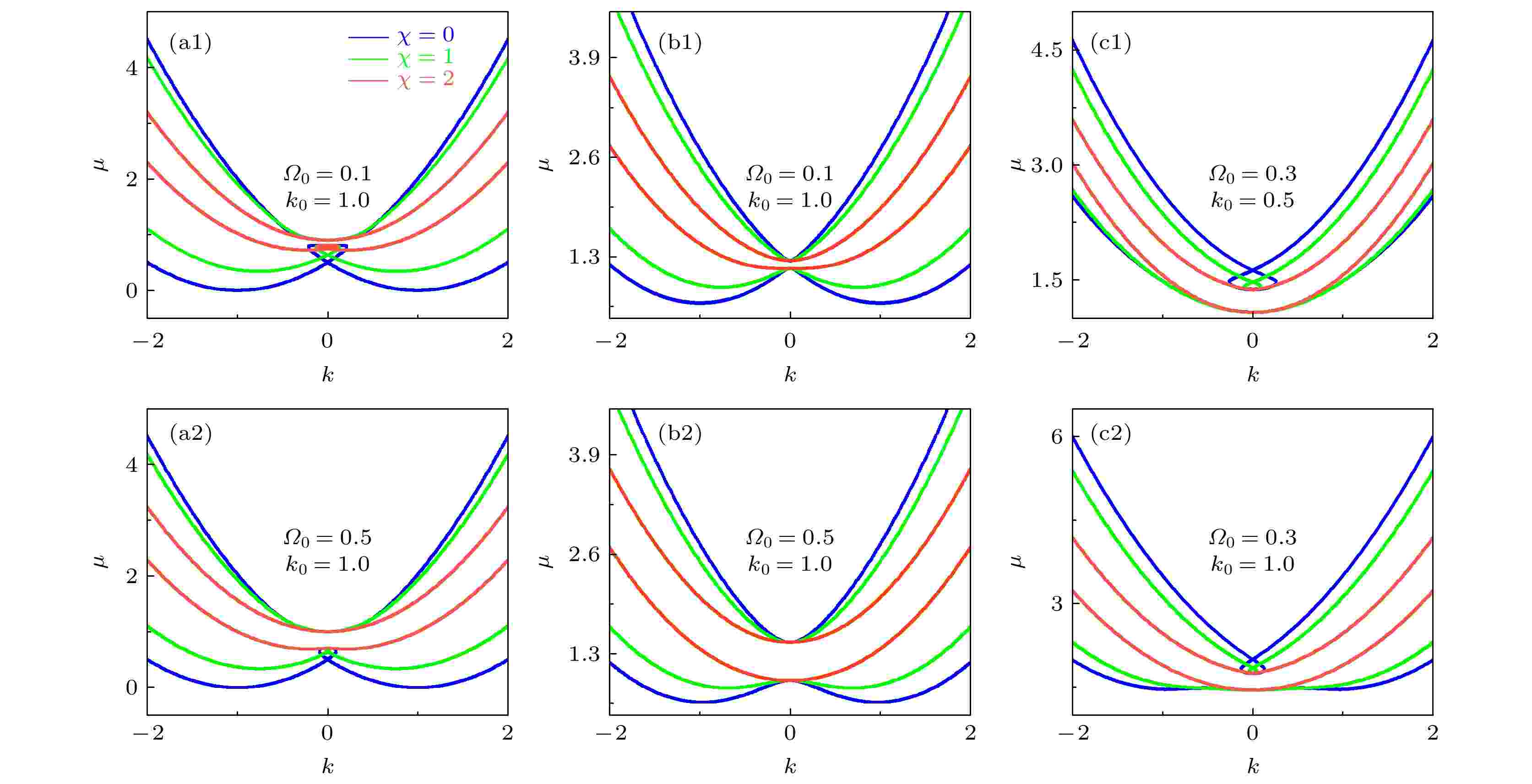
EDITOR'S SUGGESTION
2022, 71 (21): 210302.
doi: 10.7498/aps.71.20220697
Abstract +
We theoretically study the band structure, tunneling dynamics, and tunneling probability of tunable spin-orbit-coupled Bose-Einstein condensates under the periodic driving of Raman coupling. The time-independent Floquet Hamiltonian is obtained in the high-frequency approximation. It is found that the periodic driving can effectively tune spin-orbit coupling and nonlinear interaction. The system is mapped to a standard nonlinear two-level model, and the critical condition for the appearance of the loop in energy band structure and the width of the loop are obtained analytically. When the interspecies atomic interaction is equal to the intraspecies atomic interaction, there is no loop. However, when the intraspecies atomic interaction is smaller (larger) than the interspecies atomic interaction, the loop appears in the lower (upper) energy band. In this case, both spin-orbit coupling and Raman coupling will suppress the appearance of loop. In particular, the critical condition for the appearance of loop structure can be controlled by adjusting external driving. We also study the tunneling dynamics of Bose-Einstein condensate with tunable spin-orbit coupling. More importantly, by tuning the periodic driving, the tunneling dynamics of the system and the location of nonlinear Landau-Zener tunneling can be controlled. We also find that the spin components of the system can be reversed. Finally, the Landau-Zener tunneling probability of the system is calculated. The research shows that the periodic driving can effectively change the tunneling probability of the system.
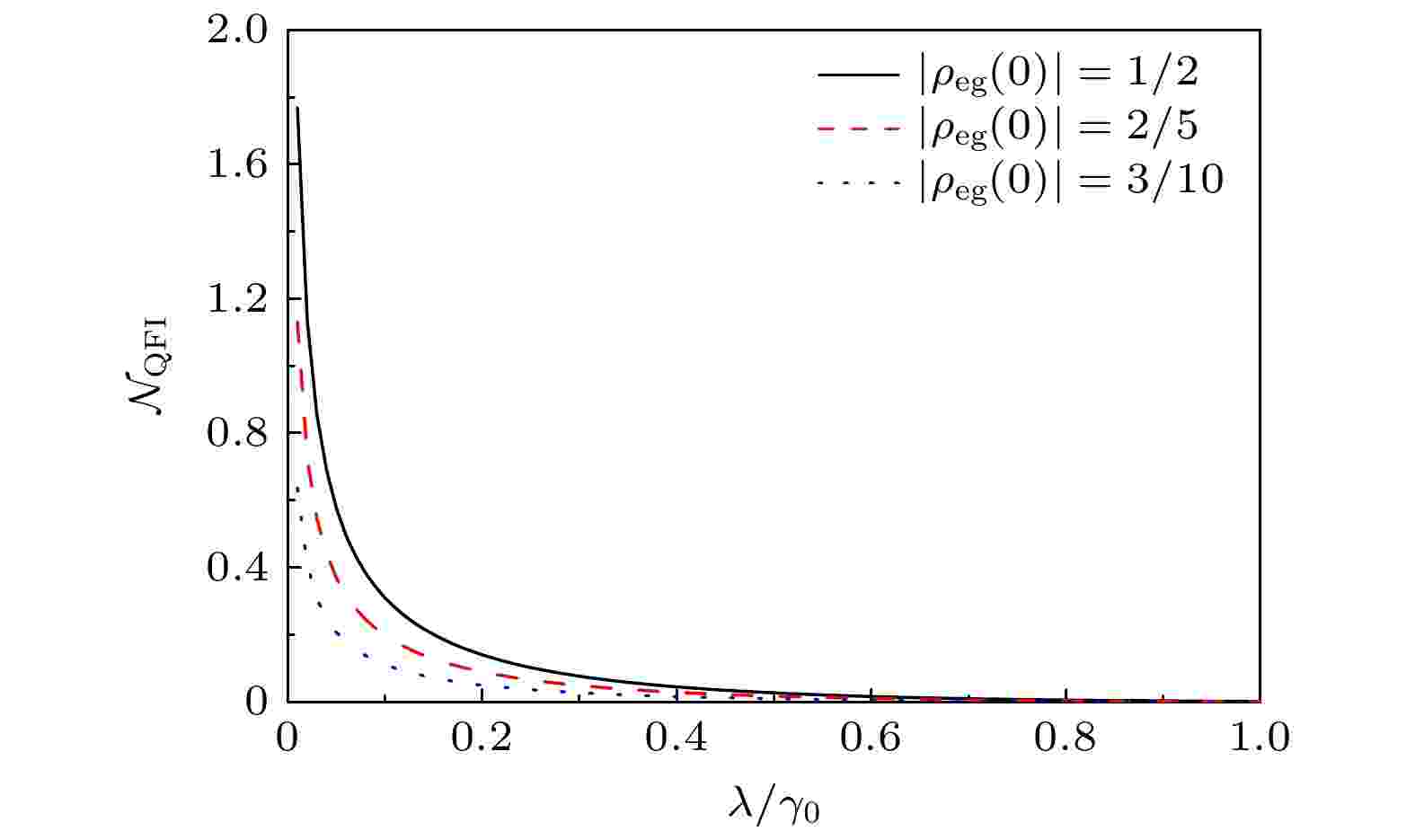
EDITOR'S SUGGESTION
2022, 71 (21): 210303.
doi: 10.7498/aps.71.20221053
Abstract +
In recent years, quantifying non-Markovian effect in open quantum system has become an important subject in the quantum decoherence control field. In this paper, a non-Markovian measure independent of the initial state of open system is proposed, thereby extending non-Markovian measure based on quantum Fisher information from the case where the initial state of the system is a pure state to the case where the initial state of the system is an arbitrary mixed state. As its application, the non-Markovian process is quantified by quantum Fisher information about a two-level system undergoing the three well-known dissipative channels, i.e. amplitude dissipative channel, phase damping channel, and random unitary channel. The results show that the conditions of non-Markovian processes in the three dissipative channels are independent of the selection of the initial state of the system by means of the quantum Fisher information of a phase parameter. Further, for amplitude dissipation channel and phase damping channel, the conditions for the non-Markovian processes to occur are equivalent to those given by trace distance, divisibility, quantum mutual information, quantum Fisher-information matrix, et al. As expected, for the case of amplitude dissipation channel, the corresponding results can reduce to the one in other paper (Lu X M, Wang X G, Sun C P 2010 Phys. Rev. A ) by selecting the initial state of the system as an optimal pure state. However, for random unitary channel, the conditions of non-Markovian process are not equivalent to those for other measures. In addition, we also obtain an interesting relationship between quantum Fisher information and quantum coherence of the open system in the three dissipative channels, namely the square of quantum $l_1$ coherence for the evolved state of system is exactly equal to the quantum Fisher information of the phase parameter. In a word, the obtained results not only improve the application scope of using the quantum Fisher information to detect non-Markovian effects in open systems, but also further highlight its important role in quantum information processing.
2022, 71 (21): 210401.
doi: 10.7498/aps.71.20220876
Abstract +
Neutrinoless double beta decay has not been observed so far, and its existence cannot be disproved. Therefore the question whether neutrinos are Majorana particles is still inconclusive. In this paper, we hope to investigate the possibility of distinguishing neutrino fermion types by gravitational fields from the perspective of gravitational scattering of fermions. The Levi-Civita connection is decomposed according to the parity transformation. Under the perturbation therory of gravitational field to fermion quantum scattering and weak gravitational approximation, it is found that the difference between Dirac and Majorana fermion quantum scattering matrix elements of general metric gravitational field comes from similar vector parts under parity transformation; the scattering of the gravitational field on the Kerr metric confirms that the difference in scattering among different types of fermions is related to the angular momentum of the Kerr gravitational source, whose scattering matrix elements are proportional to the square of the product of the mass of the gravitational source and the angular momentum. The above results provide another possible way to distinguish fermion types by gravitational fields.
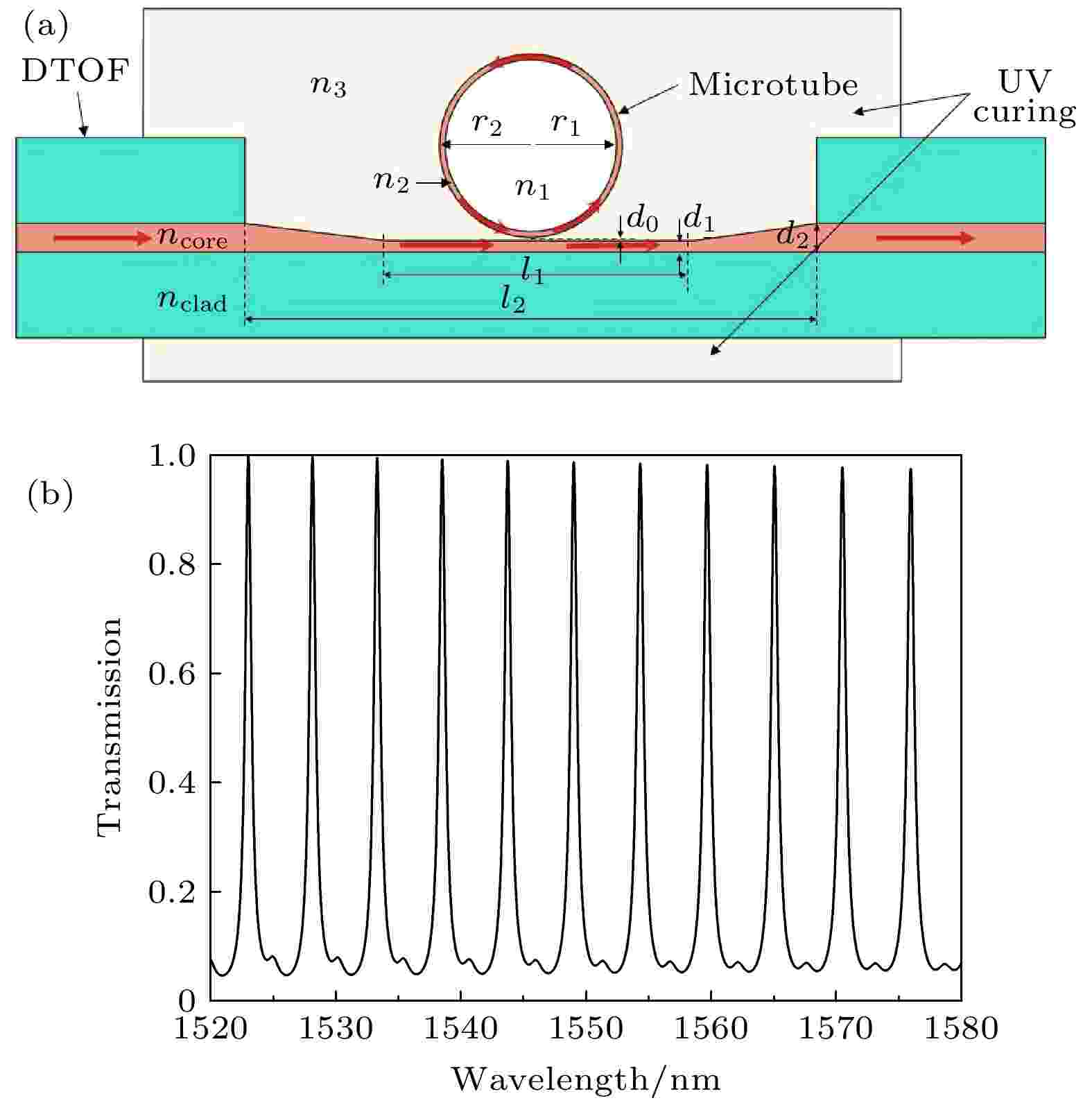
2022, 71 (21): 210701.
doi: 10.7498/aps.71.20221137
Abstract +
Based on the coupling between the D-shape fiber and the microtube resonator in the whispering gallery mode, combined with the microfluidics, a refractive index sensor is proposed in this paper, in which the coupling region is fully encapsulated. This sensor requires a very little liquid sample (about 5 nL), is not fragile, and has better resistance to environmental perturbation, portability and repeatability than the general fiber-microcavity-coupled sensor. By the numerical simulation, the resonance properties of the microfluidic microtube resonator are investigated, and the refractive index sensing performance is analyzed. The research results show that the thickness of the mircotube-wall and the liquid refractive index have a great influence on the sensor performance. The shift of the resonance wavelength has a good linear relationship with the liquid refractive index. Meanwhile, the refractive index sensitivity is high (510.5–852.7 nm/RIU), and the Q-factor reaches up to 5.53×104, the detection limit can arrive at 2.11 × 10–6.
THE PHYSICS OF ELEMENTARY PARTICLES AND FIELDS

2022, 71 (21): 211101.
doi: 10.7498/aps.71.20220659
Abstract +
By using the finite temperature field theory, the one-loop effective potential and the dynamics of the quantum chromodynamics deconfinement phase transition in the framework of Friedberg-Lee model are studied at finite temperature and density. Our results show that there is a first-order deconfinement phase transition for the full phase diagram, and the critical temperature is about 119.8 MeV for a zero chemical potential whereas the critical chemical is around 256.4 MeV when the temperature is fixed at T = 50 MeV. Moreover, in the thin-wall approximation, we investigate the dynamics of a strong first-order quark-hadron transition via homogeneous bubble nucleation in the Friedberg-Lee model. Under an appropriate boundary condition, the equation of motion for the $ \sigma $ field is solved, then the evolutions of the bubble critical configuration with radius $ r $ at different temperatures and densities are calculated. The surface tension, the typical radius of the critical bubble and the shift in the coarse-grained free energy each as a function of temperature and chemical potential are obtained. In order to gain the reliability and advantages of the thin-wall approximation, our analytical results based on the thin-wall approximation are compared with those obtained by the exact numerical method accordingly. Finally, some consequences and possible applications of our results in the quark meson model and Polyakov quark meson model are also presented in the end of this paper.
NUCLEAR PHYSICS

2022, 71 (21): 212901.
doi: 10.7498/aps.71.20220934
Abstract +
In this work, an 18 MeV self extraction high current cyclotron is designed, which provides a feasible design scheme for the self extraction system. For the main magnet, it is designed by restricting the parameter change of the main magnetic field through “three judgments”. For the self extraction system, the phase space suitable for particle extraction is scanned by injecting the phase space, and the gradient correction magnet is used to increase the acceptance of the extracted beam. For the harmonic coil, through the second harmonic change of the magnetic field, the beam characteristics are analyzed and the position of the harmonic coil is determined. Under the condition of scanning different harmonic coil surface currents, the extraction of the beam is obtained, and then the phase space of the beam is pushed to the acceptance. In order to match the radial dimension and the axial dimension of the target beam and obtain a stronger beam, the magnetic channel of the double structure is selected and the related design idea is given. The final beam size is 30.5 mm × 12.9 mm, the particles that can be extracted account for 82.62% of the successfully accelerated particles.
ATOMIC AND MOLECULAR PHYSICS
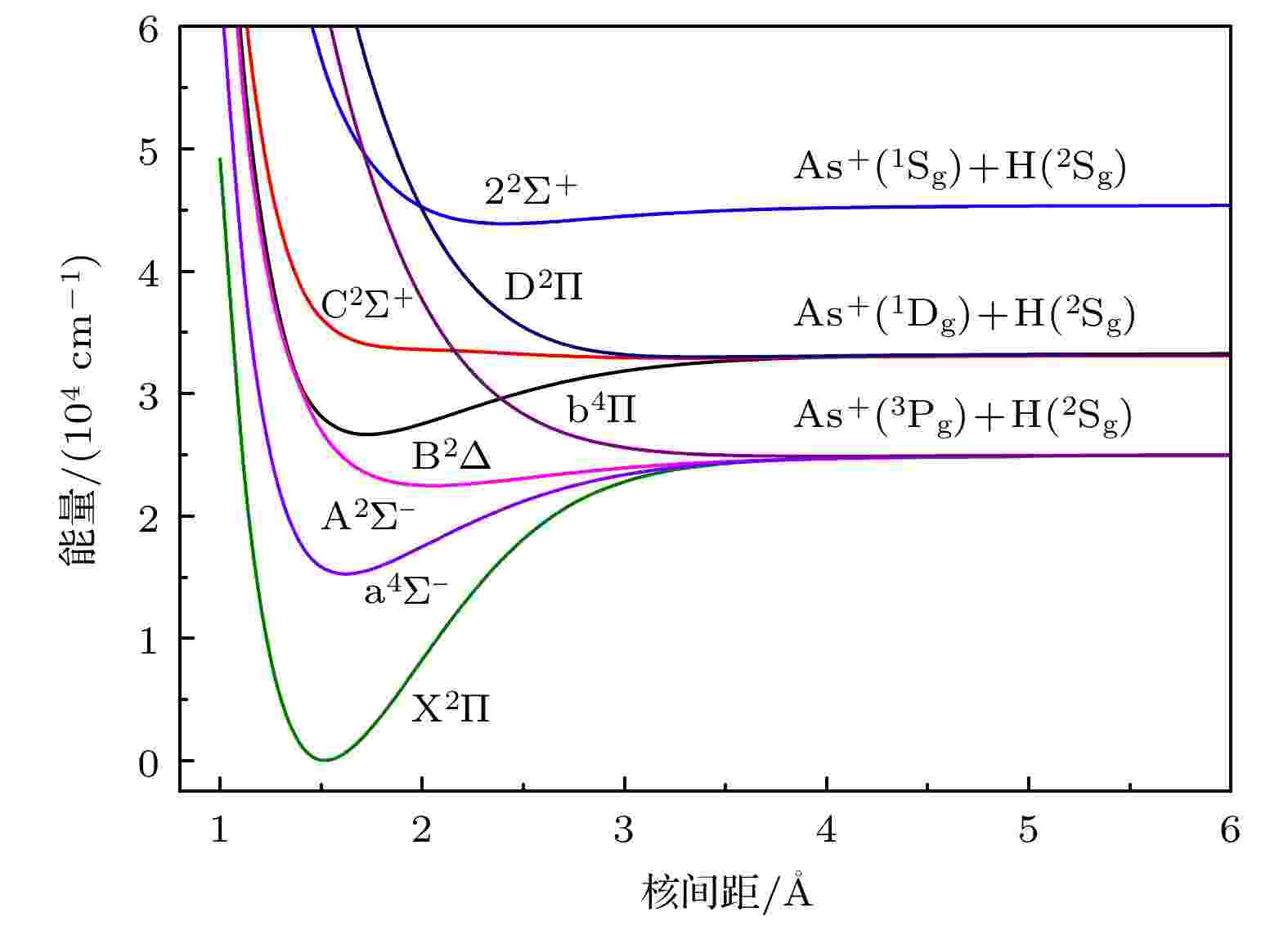
2022, 71 (21): 213101.
doi: 10.7498/aps.71.20221104
Abstract +
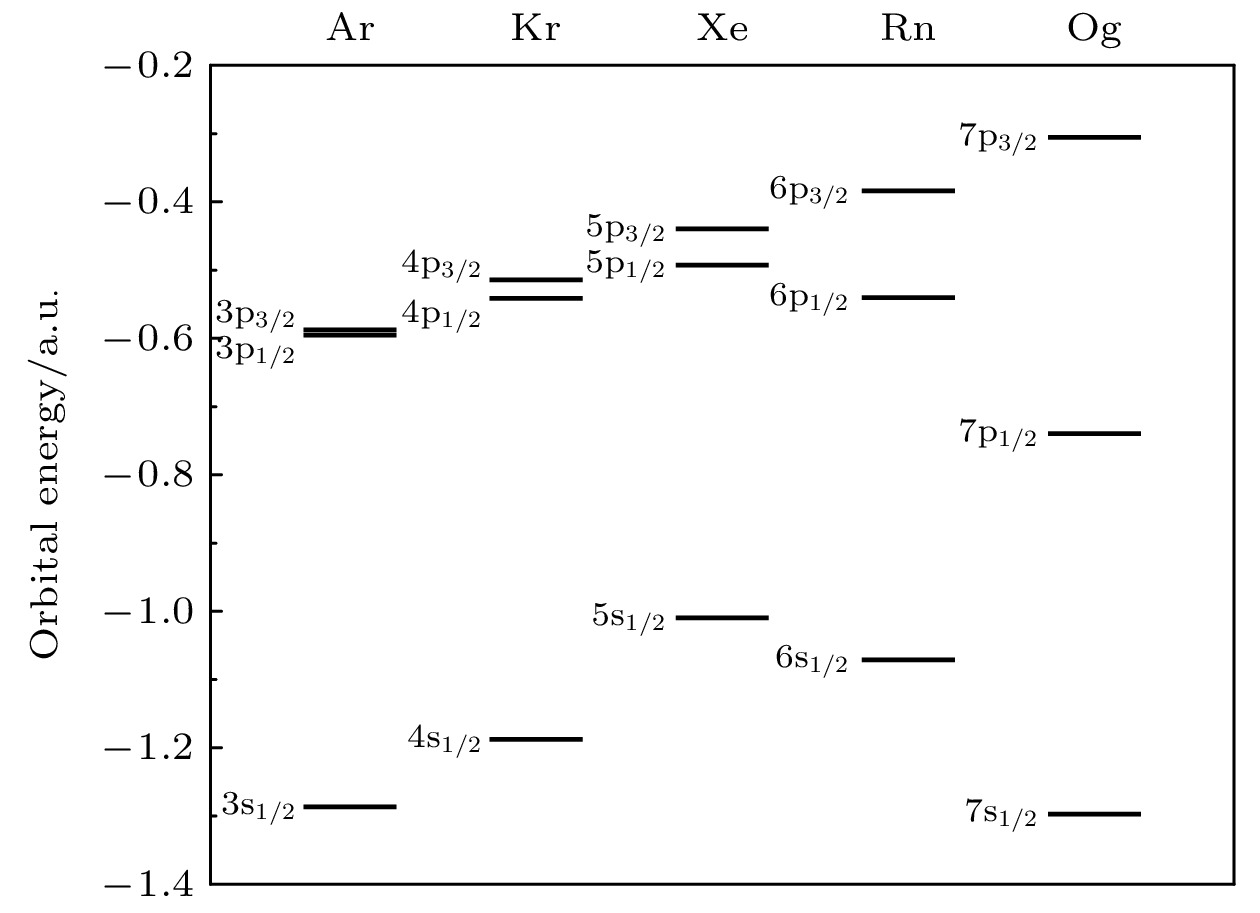
2022, 71 (21): 213201.
doi: 10.7498/aps.71.20220813
Abstract +
The ionization energy of the superheavy element Og (Z = 118) and its homolog elements Ar, Kr, Xe, Rn, and their ions are systematically calculated by using the GRASP2K program based on the multi-configuration Dirac-Hartree-Fock (MCDHF) method, taking into account relativistic effects, electron correlation effects between valence shell electrons, quantum electrodynamics effects, and Breit interaction. To reduce the uncertainty of the ionization energy derived from electron correlation effects which are not fully considered, the ionization potential of the superheavy element Og0–2+ and its homolog element Rn0–2+ are extrapolated by the extrapolation method. The ionization energy of extrapolated Rn0–5+ and Og5+ coincide well with experimental and other theoretical values. These results can be used to predict the unknown physical and chemical properties of the atoms and compounds of the superheavy element Og. In addition, the calculation results of the electron orbital binding energy of the atomic valence shell of the superheavy element Og and its homolog elements Ar, Kr, Xe, and Rn under relativistic and non-relativistic conditions show that owing to the relativistic effect, there occur strong orbital contraction phenomena in the 7s orbital and 7p1/2 orbital and strong splitting phenomena in the 7p1/2 orbital and 7p3/2 orbital of Og, which may cause the physical and chemical properties of the superheavy element Og to differ from those of other homologs.
ELECTROMAGNETISM, OPTICS, ACOUSTICS, HEAT TRANSFER, CLASSICAL MECHANICS, AND FLUID DYNAMICS
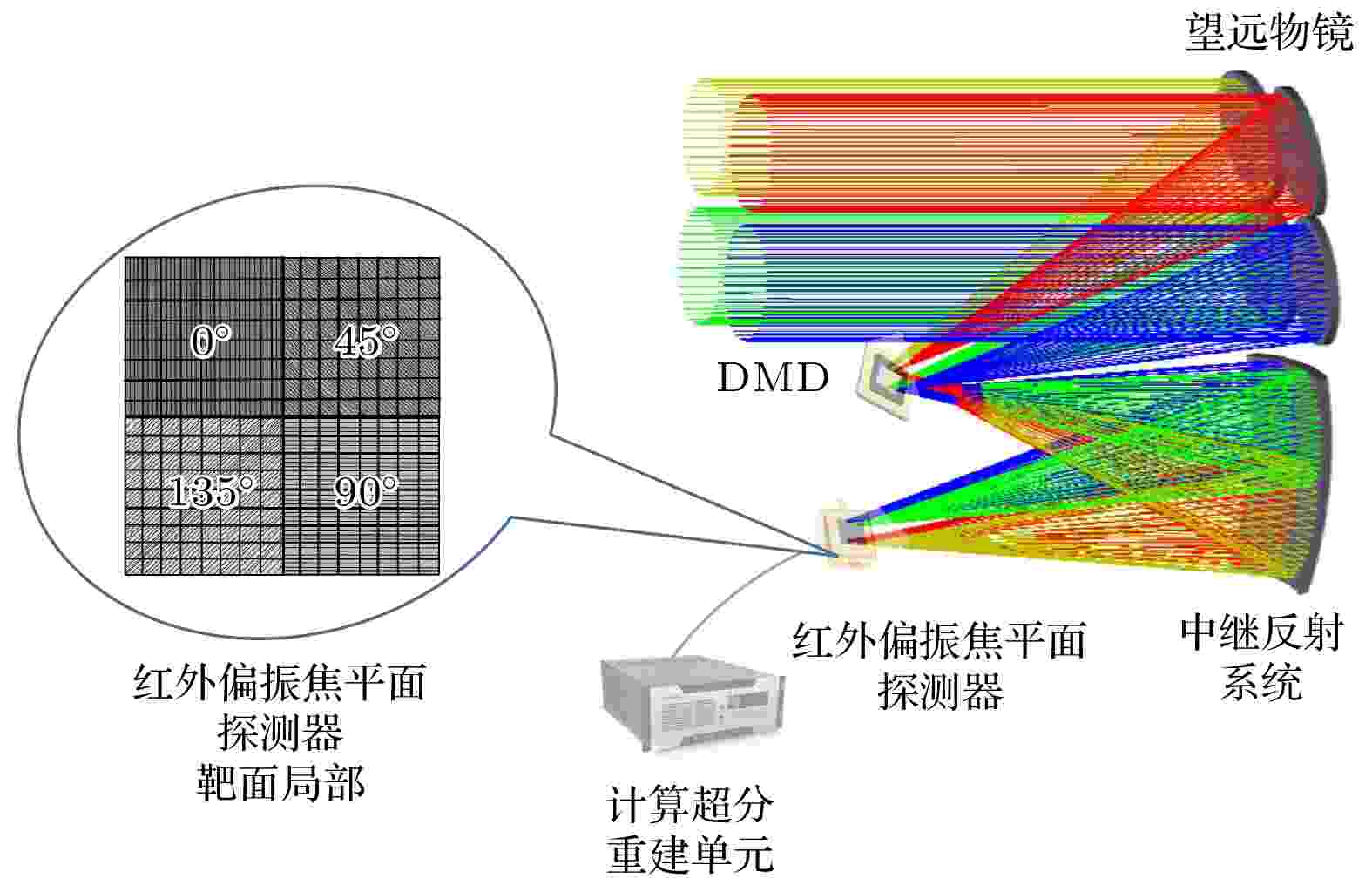
2022, 71 (21): 214201.
doi: 10.7498/aps.71.20220946
Abstract +
According to the requirements for broadband simultaneous polarization high-resolution imaging, a divided-aperture simultaneous polarization super-resolution imaging system based on reflective free-form surface optical system and digital micro-mirror device is proposed. It has the advantages of wide working wavelength band, simultaneous imaging of multiple polarization states, single detector, high resolution and lightweight. The aberration correction principle and design optimization method of the optical structure for this imaging system are given. The Wassermann-Wolf theory is further developed, and the reflective Wassermann-Wolf differential equations that eliminate a variety of aberrations are derived. At the same time, combined with Seidel aberration theory and using iterative method, the distortion elimination boundary condition is added when solving the Wassermann-Wolf equation. Through the iterative method, the optical initial structure is obtained, which can correct spherical aberration, coma, astigmatism and distortion at the same time. The initial structure is subjected to off-axis treatment and further optimized, and the user-defined optimization evaluation function is written to strictly control the position of the light falling point of each sub aperture and each field of view on the middle image plane and the final image plane, so as to effectively suppress the distortion in the final system and avoid the mismatch error between the mirror element and the pixel in the process of super-resolution reconstruction. The reconstruction quality can be improved. Finally, the design of the four-sub-aperture free-form surface off-axis reflective super-resolution imaging optical system is completed, which possesses a large relative aperture (F# = 2.5) and compact structure. The imaging quality of each polarization channel is close to the diffraction limit. The above aberration correction principle and the image quality optimization method can effectively guide the design of the wide band simultaneous polarization super-resolution imaging optical system.
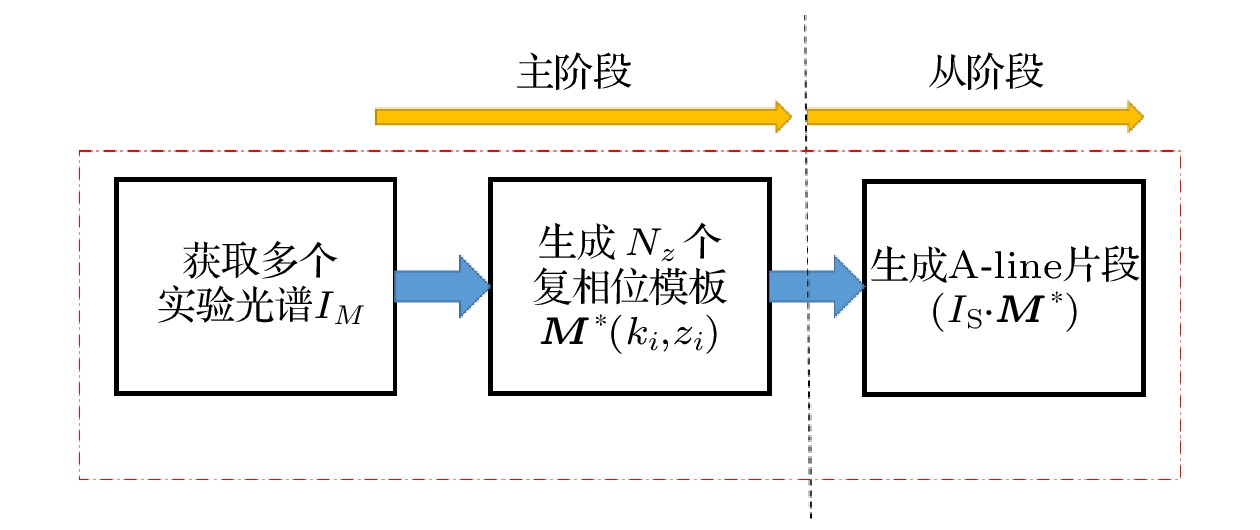
2022, 71 (21): 214202.
doi: 10.7498/aps.71.20220444
Abstract +
Spectral-domain optical coherence tomography (SD-OCT) system has the advantages of non-invasive, non-contact, fast imaging and low cost. It has important applications in the measurement of discrete interface of optical lens. However, the interference spectrum collected by spectral domain OCT system inevitably encounters some problems such as the unequal interval spectrum sampling and chromatic dispersion between two interference arms. In order to ensure that the axial resolution and sensitivity of the system are not reduced, subsequent data processing steps such as spectrum resampling and dispersion compensation need adding, which greatly reduces the real-time performance of measurement. In addition, in the actual measurement process, the required imaging area is often only a small part of the whole imaging area, the calculation of the whole imaging area brings a certain waste of computing power and resources. Moreover, in the positioning of discrete interface, the existence of sub-pixel deviation under limited axial resolution limits the measurement accuracy of interface. To solve the above problems, in this work proposed is a method of fast locating discrete interfaces based on complex master slave (CMS) OCT phase information. By combining the phase information of spectral domain and depth domain, the reconstruction template of CMS-OCT is solved accurately, and the phase information of CMS-OCT is used to achieve high-precision optical path difference detection and discrete interface location. Finally, experiments with precise optical gauge and discrete interface of optical lens verify that the proposed method can maintain high resolution and stability while fast locating is implemented.
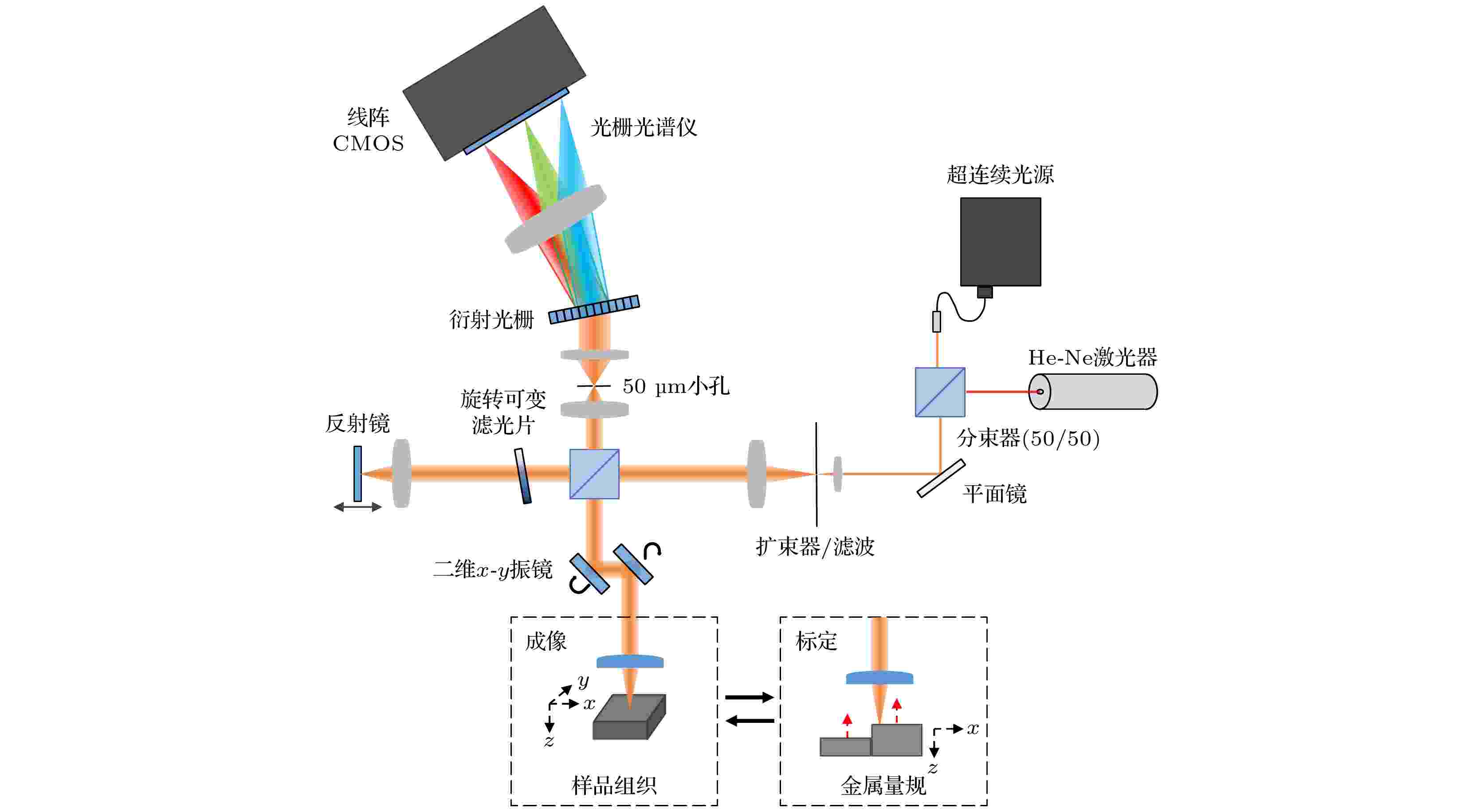
2022, 71 (21): 214203.
doi: 10.7498/aps.71.20220314
Abstract +
Spectral-domain optical coherence tomography (SD-OCT) systems generally have nonlinear sampling problems in wavenumber domain. In order to realize the precise positioning of the discrete interfaces and the high-quality reconstruction of OCT images under conventional fast Fourier transform, it is necessary to solve the precise calibration problem of the absolute wavenumber of the discrete sampling points in the spectrometer. In this work, an absolute wavenumber calibration method is proposed based on the absolute phase of the characteristic spectral line and the constraint polynomial fitting phase under precise optical path difference. In the sample arm of the SD-OCT system, the metal gauges with precise thickness difference are used to obtain the absolute phase value of the characteristic spectral line, and the phase wrapping times corresponding to the characteristic spectral line are further accurately solved. Thus, this method overcomes the 2π ambiguity of spectral phase in conventional interferometric phase methods. At the same time, combined with the polynomial fitting phase of the high signal-to-noise ratio region under window constraint, the accurate calibration of the absolute wavenumber of each sampling point is realized. Finally, comprehensive comparison between the proposed method and the traditional resampling method in terms of discrete interface positioning, axial resolution and image reconstruction quality verifies the significant advantages of this method.
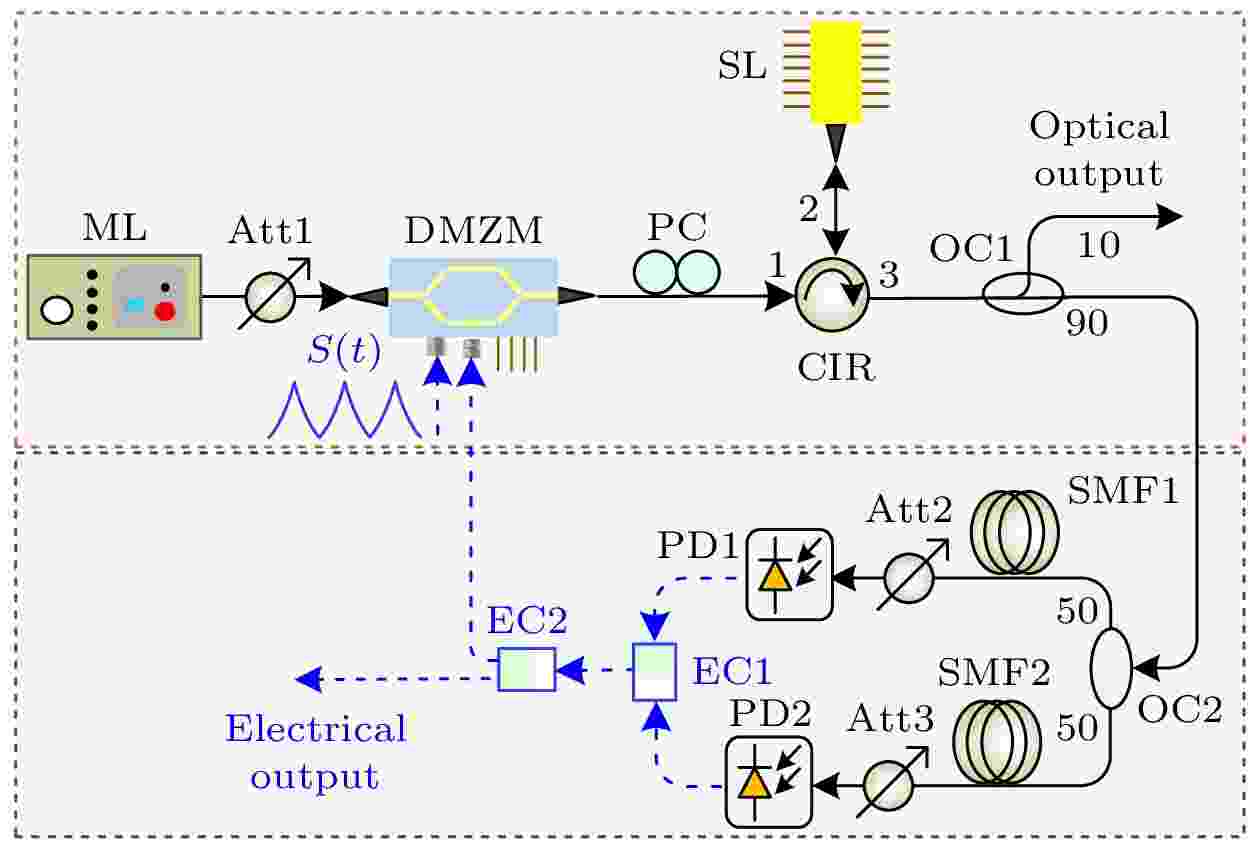
2022, 71 (21): 214204.
doi: 10.7498/aps.71.20221308
Abstract +
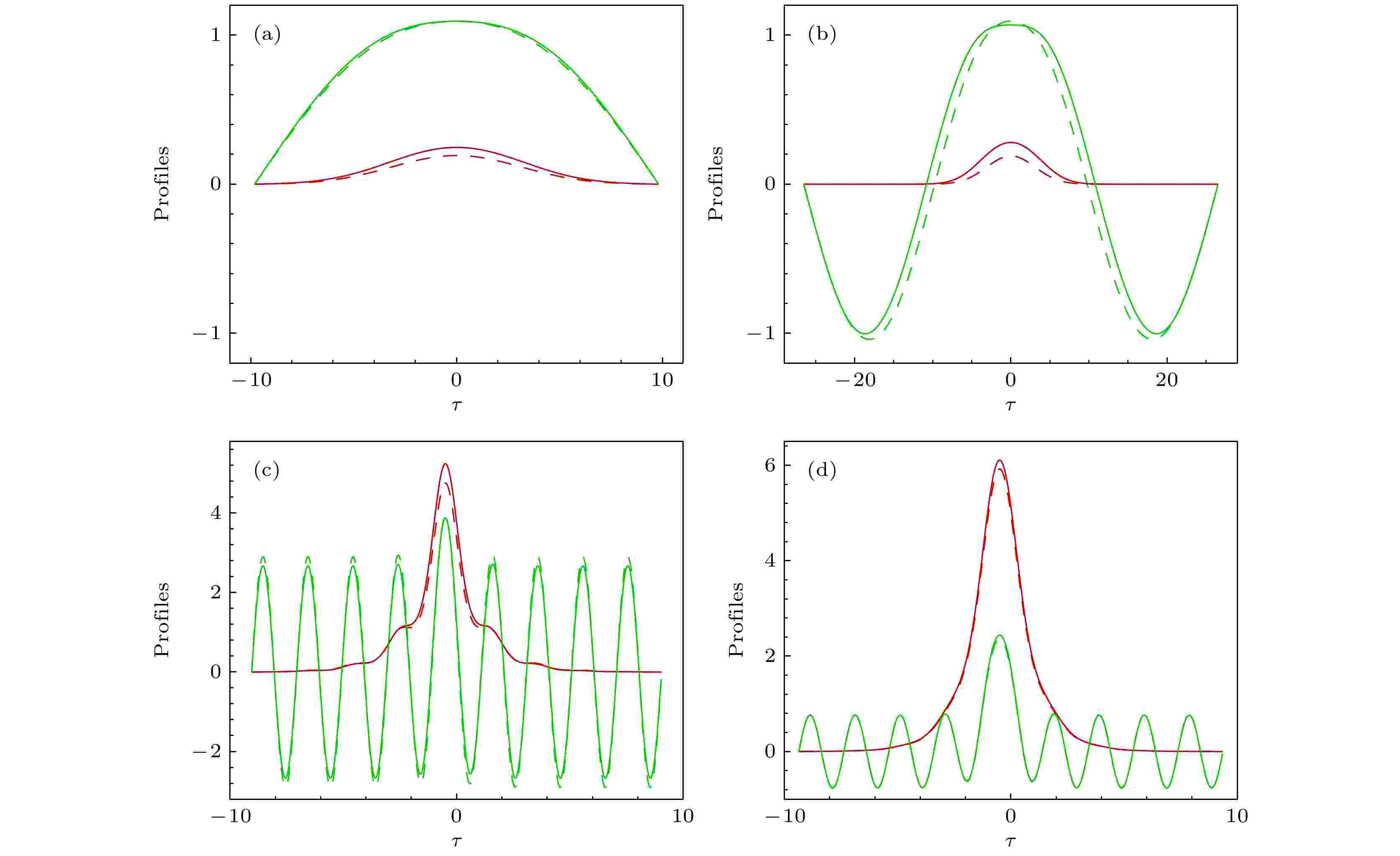
2022, 71 (21): 214205.
doi: 10.7498/aps.71.20220865
Abstract +
In this paper, we theoretically study the influence of cubic nonlinearity effect on quadratic solitons in the boundary-constrained self-focusing oscillatory response function system. Based on the Newton iteration approach, we numerically solve the nonlinear coupled-wave equations with both quadratic and cubic nonlinearity. Moreover, a family of quadratic solitons is obtained. By comparing the quadratic solitons with both quadratic and cubic nonlinearity with those with only quadratic nonlinearity, we find that the cubic nonlinearity changes the transverse distribution of the soliton profiles only slightly. However, because of the existence of the cubic nonlinearity, quadratic solitons can be found only in the strongly nonlocal case and general nonlocal case, and they cannot be found in the weakly nonlocal case, in which the quadratic solitons with only quadratic nonlinearity can be found. In addition, the existence of cubic nonlinearity reduces the number of extended half-periods of the quadratic solitons. Through the linear stability analysis of the obtained soliton solutions, it is found that the stability intervals of solitons are also shrunk due to the existence of the cubic nonlinearity. The results of the linear stability analysis are verified by the numerical simulations of soliton propagations through using the split-step Fourier method.
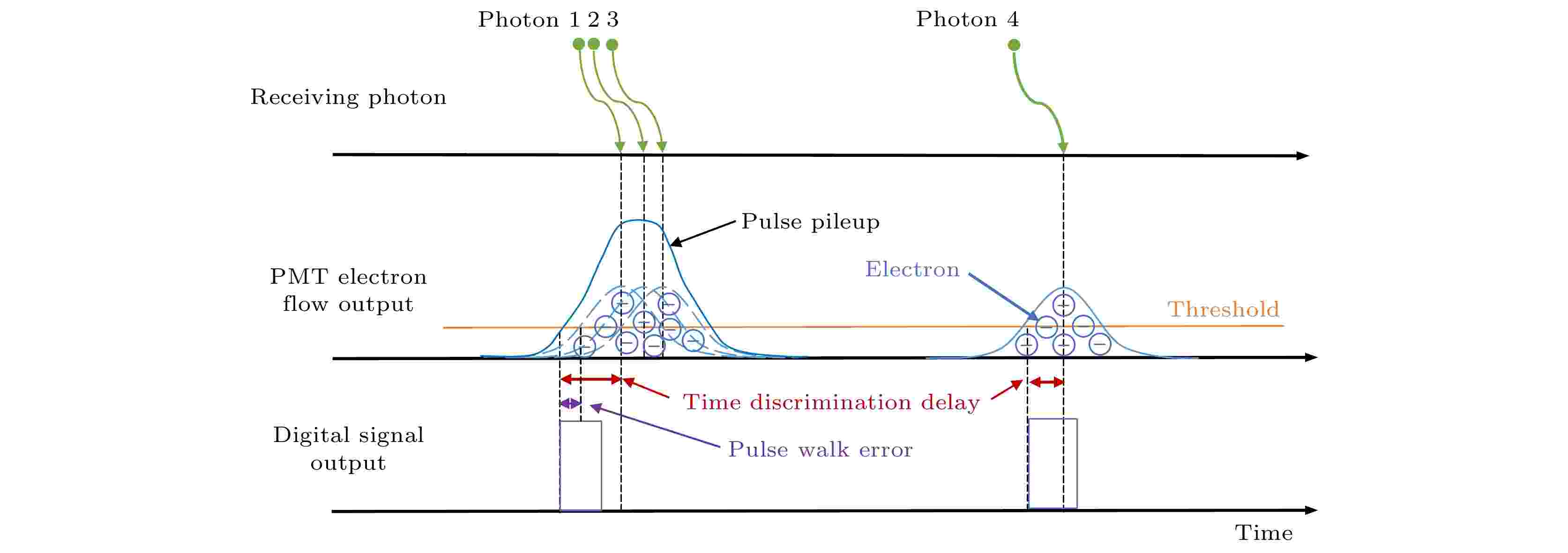
2022, 71 (21): 214206.
doi: 10.7498/aps.71.20220537
Abstract +
Photomultiplier tube (PMT) features single photon level sensitivity, low dark count, and low afterpulse probability, and are widely used in photon-counting lidar in the visible spectrum. The PMT has no photon detection dead time, for every photon it responds to, it can output an electron flow pulse, these pulses of electron flow are likely to pile up into larger pulses. When using threshold identification method to identify photon-events, the stacked pulse will introduce additional pulse walking error, directly affecting the ranging precision of photon-counting ranging method in the practical application of laser ranging. Considering the influence of pulse pile-up, a new theoretical model of PMT photon detection is established to describe the influence of pulse pile-up on the detection probability of photon-events by analyzing the relationship between the detection time of photon and the identification time of the PMT final output photon-events. Through Monte Carlo simulation, the relationship among the ranging walking error, ranging accuracy, incident laser pulse width, PMT output electron flow pulse width and photon-events identification threshold is obtained. In order to verify the correctness of the theory, a PMT-based photon-counting lidar system is built. The comparative experiment with GM-APD proves that the influence of pulse pile-up on PMT photon-counting ranging method cannot be ignored, and that the experimental results are in good agreement with results from the theoretical model. The PMT photon detection model based on pulse pile-up can guide the design of PMT photon-counting radar and improve the ranging accuracy and precision of the ranging system.
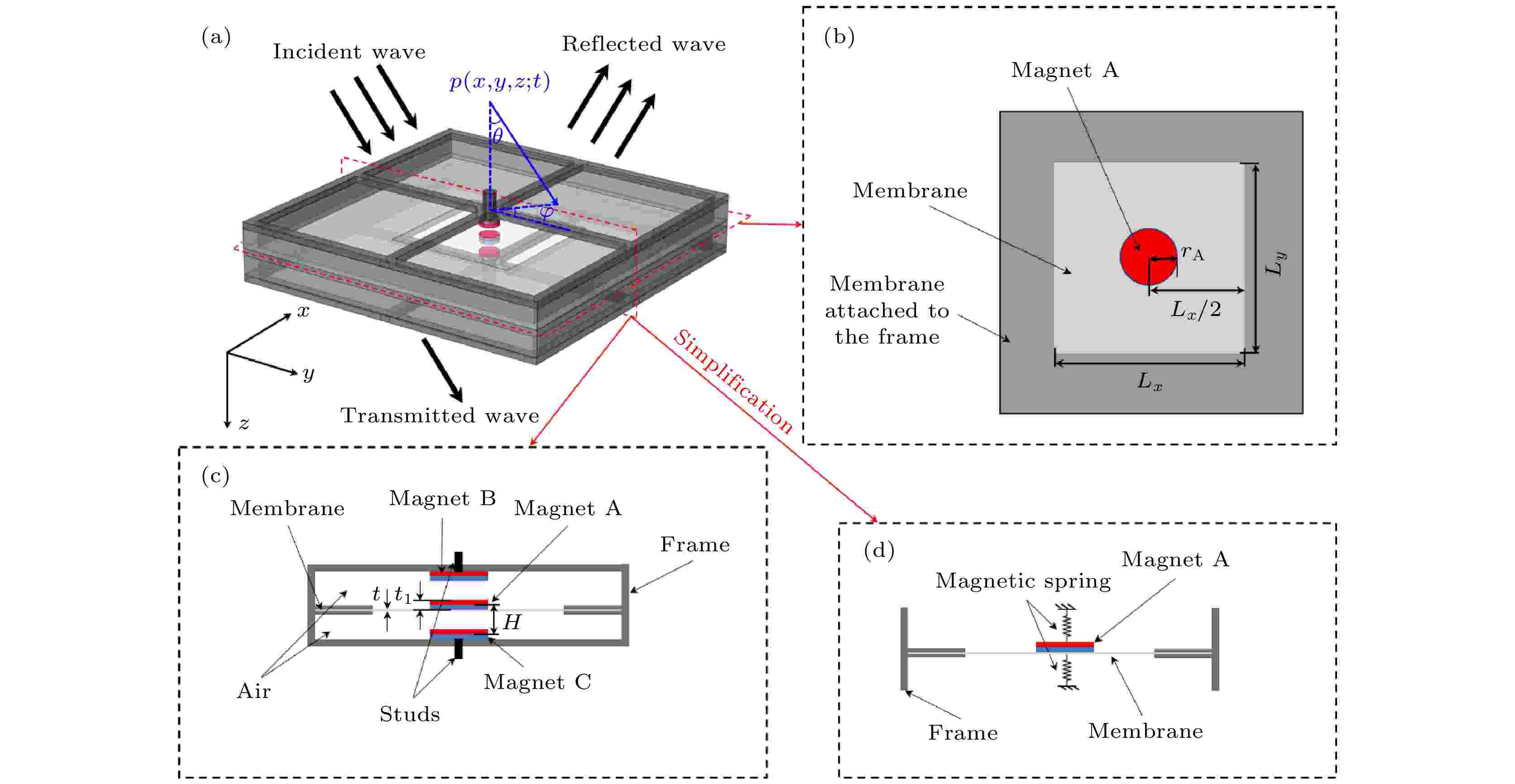
2022, 71 (21): 214301.
doi: 10.7498/aps.71.20221058
Abstract +
For improving the low-frequency sound insulation properties of membrane/plate structures, a new quasi-zero stiffness membrane acoustic metamaterial with dynamic magnetic negative stiffness is proposed. When the equivalent magnetic charge theory is used to investigate the dynamic magnetic negative stiffness, a theoretical model of proposed metamaterial with finite dimension is established based on the Galerkin method. Through a combination of theoretical analysis, numerical simulation and experimental measurement, the low-frequency (1–1000 Hz) sound insulation performance of the metamaterial is investigated from several perspectives, including structural modality, vibration mode, average velocity, phase curve, equivalent mass density, and equivalent spring-mass dynamics model. The results show that at a certain initial membrane tension, the decreasing of the magnetic gap or the increasing of the residual flux density can increase the dynamic magnetic negative stiffness. This in turn leads the peak frequency to decrease and the bandwidth of sound insulation to increase, thus achieving effective low-frequency sound insulation over a wide frequency band. Further, when the magnetic gap is larger than the second critical magnetic gap and smaller than the first critical magnetic gap, the first-order modal resonance of the metamaterial disappears, and the corresponding value of sound insulation valley increases significantly, thus demonstrating superior sound insulation effect in a wide frequency band. The proposed method of using dynamic magnetic negative stiffness to improve low-frequency sound insulation valleys due to modal resonance provides useful theoretical guidance for designing membrane/plate type low-frequency sound insulation metamaterials.

2022, 71 (21): 214302.
doi: 10.7498/aps.71.20220566
Abstract +
Acoustic signals can travel thousands of kilometers in seawater, and the characteristics of long-range sound propagation are different from short range propagation. This paper is based on a long-range underwater acoustic experimental data obtained from the western Pacific Ocean, where the farthest propagation distance is nearly 2000 km. The ocean environment information and vertical line array information are carefully processed. We analyze the attenuation of long-distance acoustic propagation in seawater and multi-path arrival structure characteristics under the complete acoustic channel environment of the ocean. In terms of the attenuation law of long-distance propagation energy, with the increase of propagation distance, the effect of seawater absorption on the attenuation of sound energy becomes prominent, and the selection of absorption coefficient is very important for the accurate prediction of sound field energy. Absorption in seawater of low frequency signals is small, and the transmission loss of acoustic signal with 100 Hz center frequency increases only by about 6 dB when the propagation distance increases from 1000 km to 2000 km. In terms of multi-path arrival structure characteristics of deep-sea acoustic channel for long-distance sound propagation, the thermocline sound velocity profile in the experimental sea area has a higher sound speed, making the number of eigenrays reaching the receiving point more and the multi-path arrival structure more complex. The arrival structure formed by sea surface reflected eigenrays is at the earlier position of the overall arrival structure and has relatively strong energy. Owing to the influence of subtropical water over the northwest Pacific Ocean on the sound speed profile, the time of some eigenrays arriving at the receiving point is earlier, and the length of multi-way arrival structure on the time axis is prolonged.
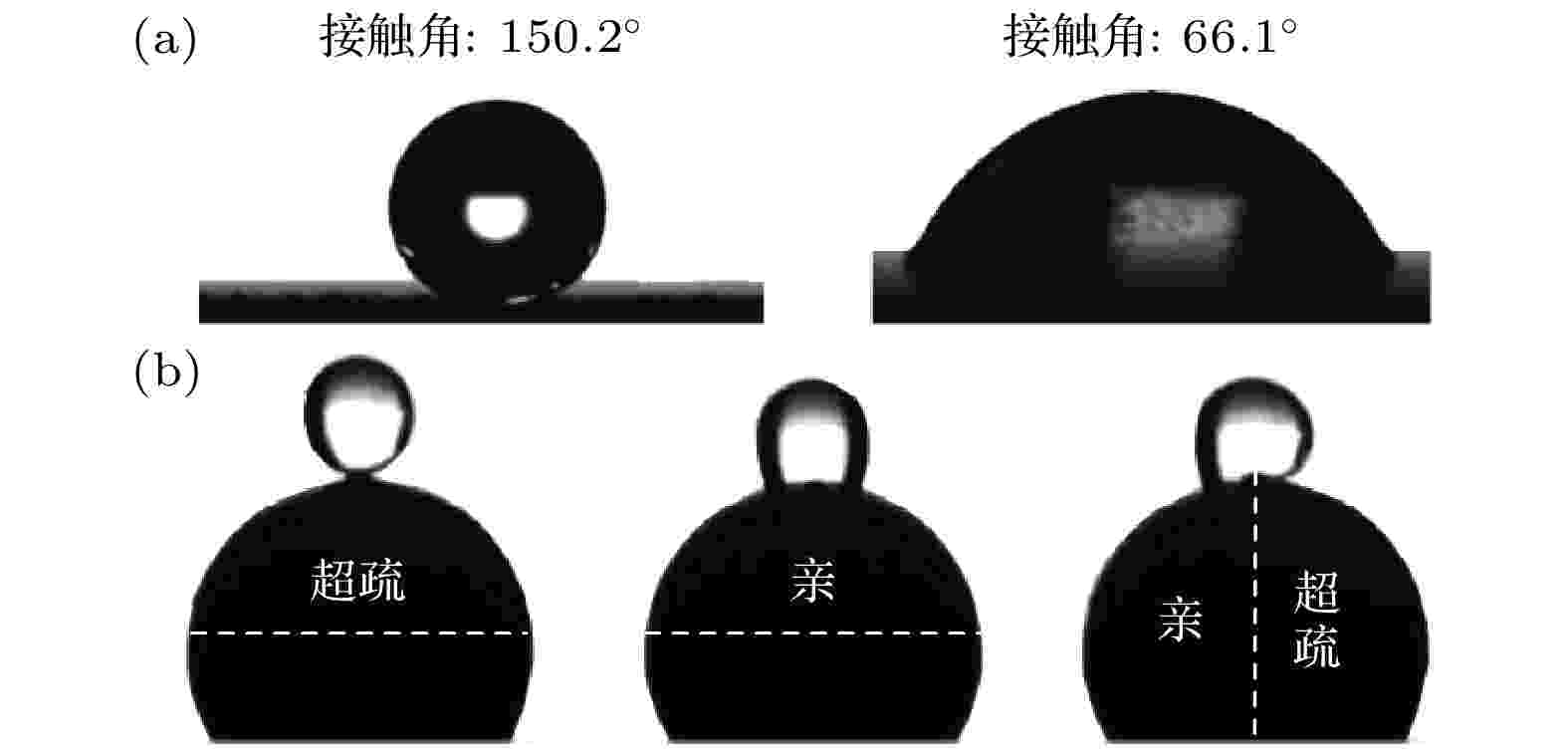
2022, 71 (21): 214701.
doi: 10.7498/aps.71.20220632
Abstract +
In order to better apply amphiphilic Janus particles to phase change heat transfer, the hydrophilic-superhydrophobic Janus particles are prepared with copper balls. The particle size is 1.0 mm and the bubble diameter is 3.0 mm. The behavior of Janus particle with small bubbles impinging on bubbles at different heights is studied. The falling heights are 0, 10.0, 20.0, 30.0 and 40.0 mm. The results show that there are obvious differences in behavior characteristic among Janus particles with different wettability surfaces when they hit the bubble. When the superhydrophobic side contacts the bubble, it will slide to the bottom of the bubble without rotation along the bubble surface; when the hydrophilic side contacts the bubble, it will first slide along the bubble surface for a certain distance, and then rotate, resulting in strong disturbance to the bubble. When the interface between hydrophilic and superhydrophobic contacts the bubble, the particle will start to rotate at the moment of contact. When Janus particle impacts the bubble at a certain height, the hydrophilic surface generally contacts bubble first. With the increase of height, the degree of deformation of Janus particles pulling bubbles increases. The force analysis shows that the main reason for the rotation of Janus particles is that the action points and directions of capillary force acting on different wettable surfaces are different, resulting in corresponding rotation torque.
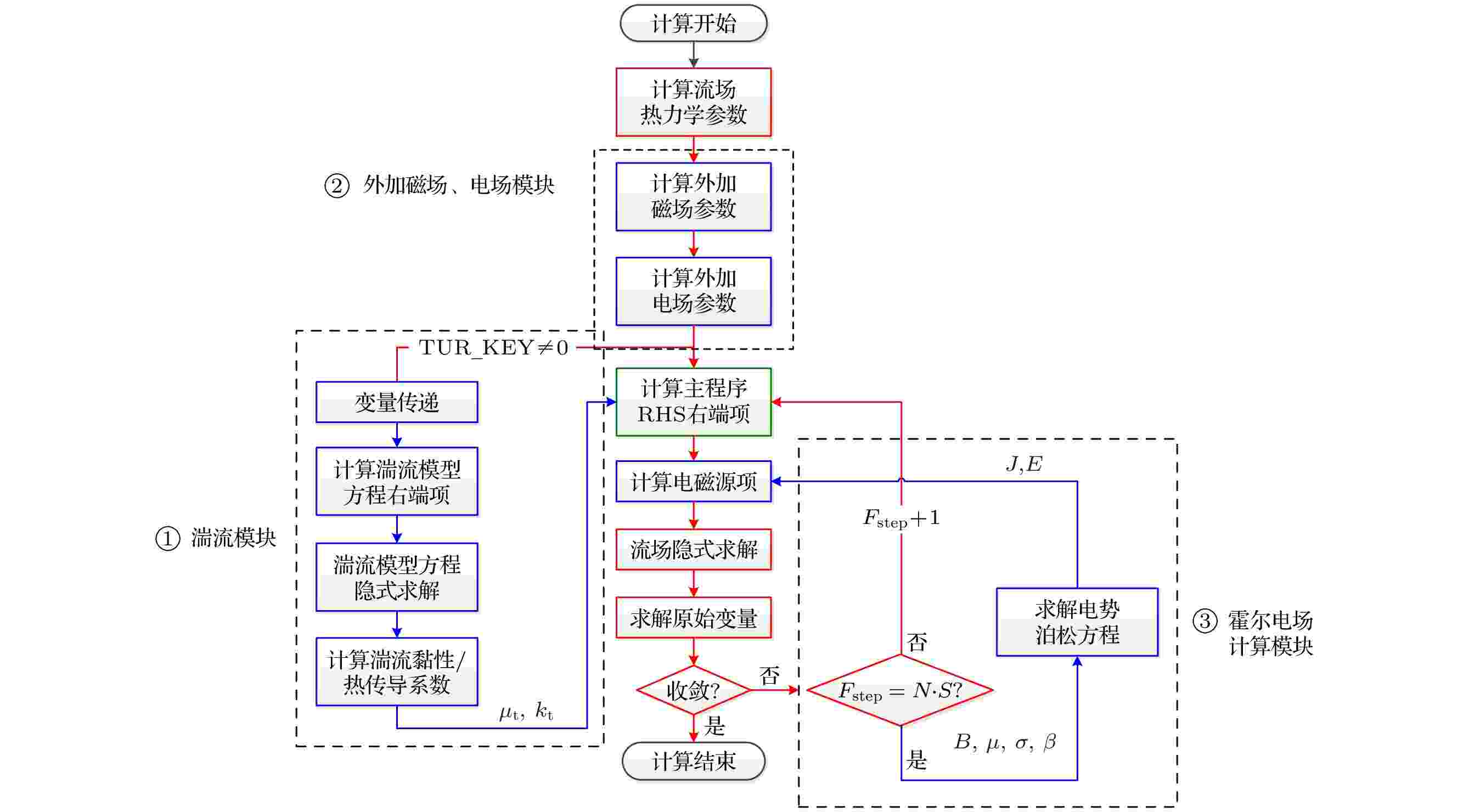
2022, 71 (21): 214702.
doi: 10.7498/aps.71.20220941
Abstract +
Under the assumption of the low magnetic Reynolds number, the coupled model is established for the turbulent flow field and the externally applied magnetic field. The AUSMPW+ scheme and LUSGS method are used to solve turbulent magnetohydrodynamics (MHD) flow equations, in which the Spalart-Allmaras one-equation turbulence model is used. A series of numerical simulations over various geometry configurations, namely, a flat plate and a compression corner, is conducted by using an external electromagnetic field. Results show that the performance of MHD boundary layer flow control is determined mainly by the Lorentz force in the streamwise direction. With an external magnetic field used, the low velocity fluid in the boundary layer can decelerate and increase the static temperature locally. Moreover, the counter-flow Lorentz force always brings a negative effect on the turbulent skin friction coefficient, and the location for the MHD zone has a great influence on the control efficiency of the ramp-induced separation. A reasonable magnetic field layout scheme should be configured in practical engineering application.
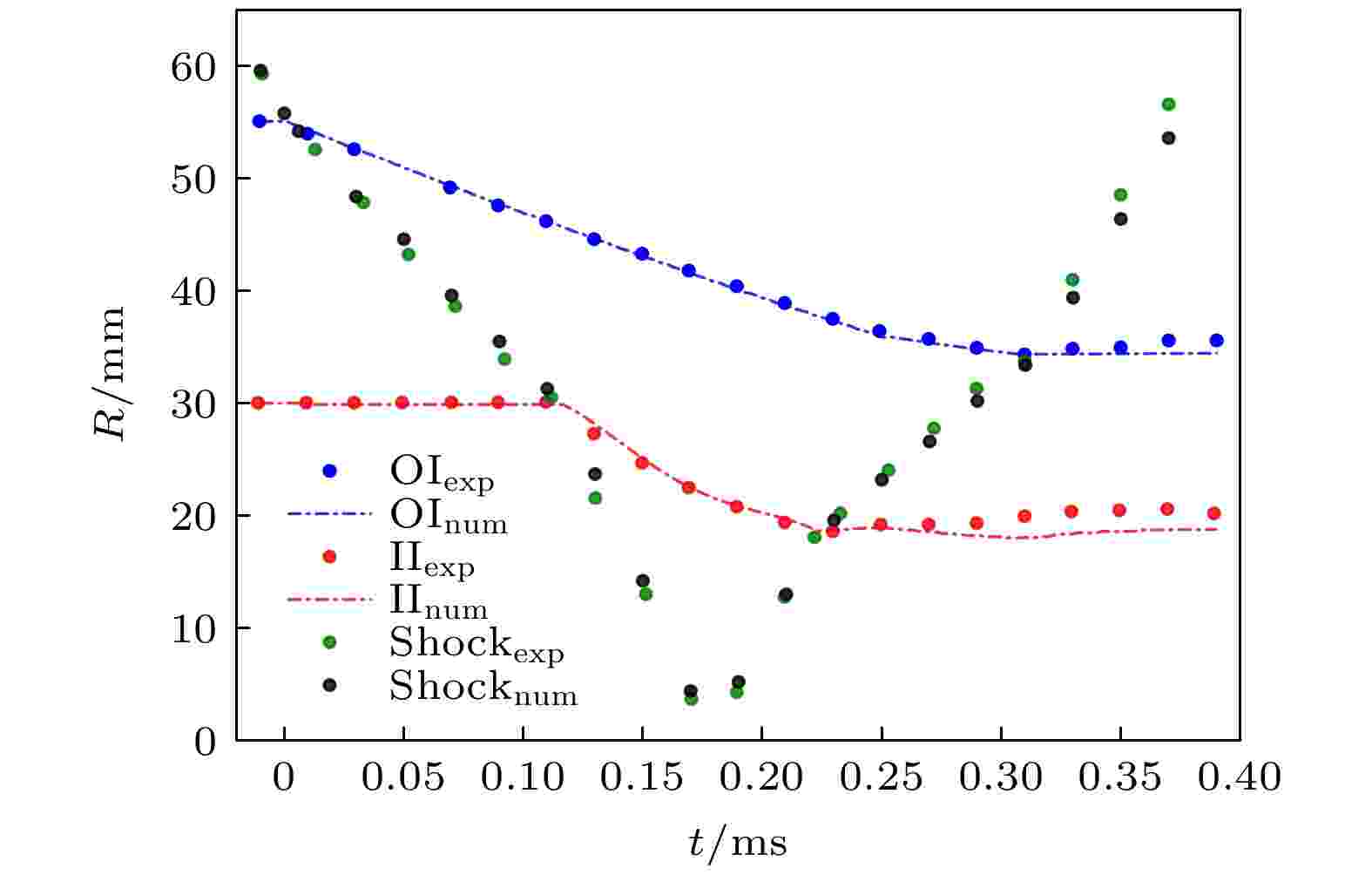
2022, 71 (21): 214703.
doi: 10.7498/aps.71.20221012
Abstract +
Based on Navier-Stokes equations, combining the fifth-order weighted essentially non-oscillatory scheme with the adaptive structured grid refinement technique, the interactions between converging shock and annular SF6 layers with different initial perturbation amplitudes and thickness are numerically investigated. The evolution mechanism of shock structure and interface are revealed in detail, and the variations of the circulation, mixing rate and turbulent kinetic energy are quantitatively analyzed. The dynamic mode decomposition method is used to analyze the dynamic characteristics of the vorticity. The results show that in the case with large initial perturbation amplitude, the transmitted shock wave forms Mach reflection structures both inside and outside of the inner interface of SF6 layer, and multiple shock focusing phenomena occur in the center. After the transmitted shock wave penetrates the outer interface, the circulation increases faster, and the “spike” and “bubble” structure on inner interface develop faster, so that the amplitude of the inner and outer interfaces and the gas mixing rate increase. As for the case with larger thickness of the gas layer, the phase of the transmitted shock wave changes inside the layer, which forms “bubble” at the crest of the inner interface and “spike” at the trough. When the thickness of the gas layer decreases, the crest of the inner interface does not move inside after being impacted, and “spike” and “bubble” are generated in the late stage. The dynamic modes show that the main structure of vorticity and the exchange of positive and negative vorticity on the main structure are determined by the modes with weak growth and low frequency, but the modes with weak growth and high frequency determine rapid exchange of positive and negative vorticity at the interface in the cases with weak coupling effect.
PHYSICS OF GASES, PLASMAS, AND ELECTRIC DISCHARGES
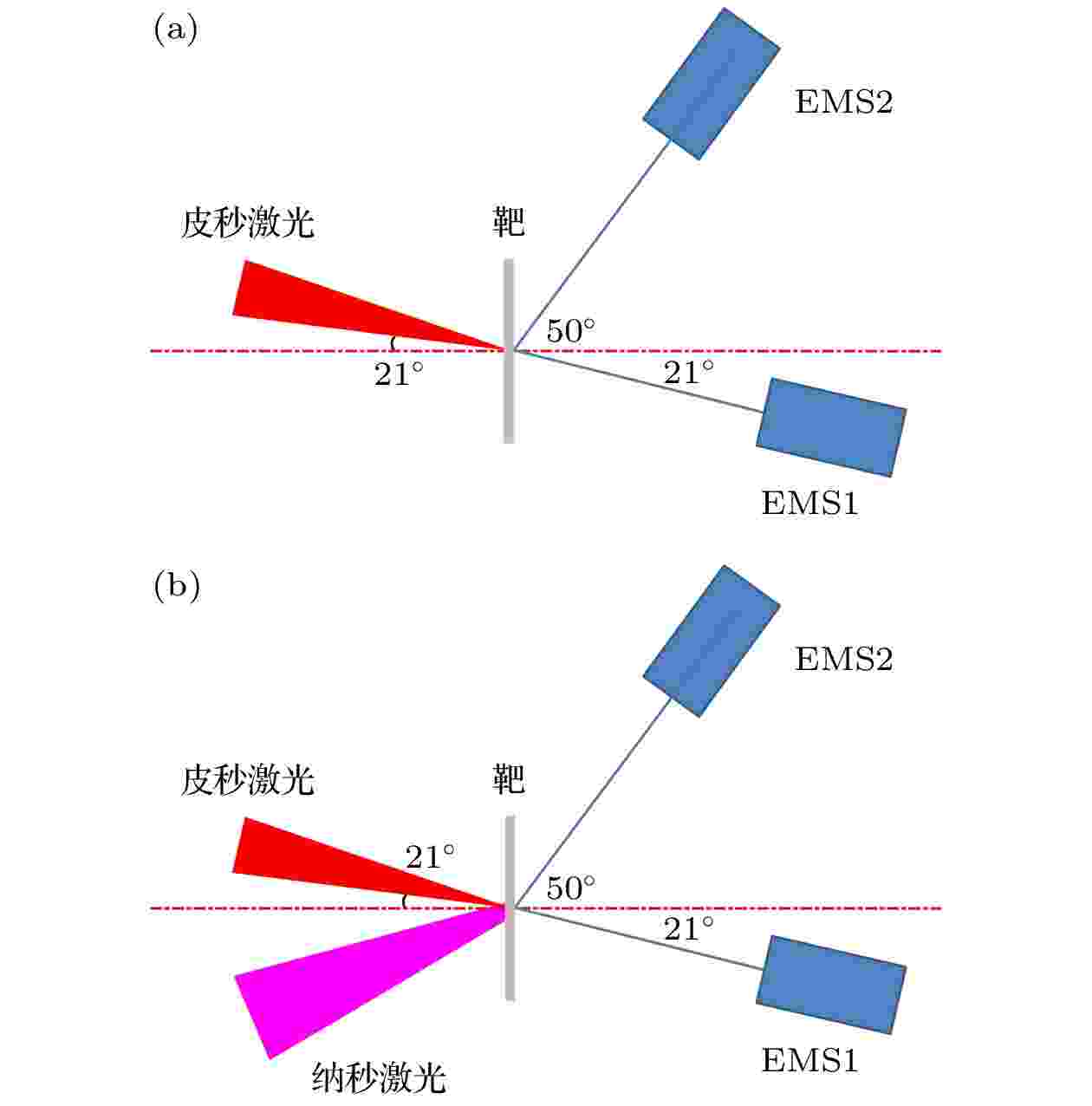
2022, 71 (21): 215201.
doi: 10.7498/aps.71.20212042
Abstract +
In order to verify that the large-scale low-density plasma has a significant gain effect on the quality of the ultra-hot electron beam in ultra-strong ultra-short pulse laser interactions with matter, on the Shenguang-II upgraded laser facility, we carry out an experimental study on the optimization of relativistic electron beams that combine long and short pulse lasers to generate large-scale low-density pre-plasma. A nanosecond laser is used to ablate the thin hydrocarbon film. After a period of time, a large-scale low-density plasma is formed. The second picosecond short pulse laser then interacts with the formed low-density plasma, and accelerates the electrons to the relativity magnitude. Through the comparative analysis between different experimental conditions in the experiment, it is found that the existence of large-scale low-density plasma significantly increases the intensity of the relativistic electron beam along the laser propagation direction. In the comparative test of three shooting methods (long and short pulse combined driving double-layer target, short pulse driving double-layer target, short pulse driving single-layer target), we find that the energy bands above 1 MeV can be produced by the long pulse and the short pulse jointly driving double-layer target. The gamma-ray intensity is nearly twice that of the other two schemes. In addition, we also find in the experiment that when the time interval between nanosecond-picosecond pulses changes, the pre-plasma electron density and density scale length of the CH film irradiated by the nanosecond laser will be different. When the time interval is 0 ns, the expansion of the plasma is still insufficient, and the density distribution of the pre-plasma is steep. Part of the picosecond laser energy will be reflected at the critical density surface. Insufficient absorption of picosecond laser energy reduces the generation of relativistic electrons.When the time interval is 1 ns, the plasma state is more appropriate. The picosecond laser will form a self-focusing plasma channel in the plasma, thereby efficiently depositing energy, breaking through the energy limit of ponderomotive force acceleration, and obtaining more higher energy relativistic electrons. When the time interval is longer, such as 1.5 ns or more, the plasma can be fully expanded, the electron density becoming too low. Most of the picosecond laser will pass through the pre-plasma, affecting energy deposition and failing to generate more relativistic electrons.
CONDENSED MATTER: STRUCTURAL, MECHANICAL, AND THERMAL PROPERTIES

2022, 71 (21): 216201.
doi: 10.7498/aps.71.20220740
Abstract +
Dynamic compression experiments on cubic polymethyl methacrylate (PMMA) specimens and two kinds of trapezoid PMMA specimens are carried by changing the transmission bars into steel bar and aluminum bar on the experimental device of split Hopkinson pressure bar (SHPB). The compression processes of PMMA specimens are recorded by high-speed photography, and the breakage processes of PMMA specimens are analyzed based on the force displacement curves and high-speed images. The evolutions of deformation and diffusion resistances of PMMA specimens under impact loading are discussed. The results show that the failure of the sample is caused mainly by the partial failure front at the contact end, and then the failure front propagates to the inside of the sample, leading the sample to break. The failure front of cubic sample is generated preferentially at the transmission end under low speed impact and at the incident end under the higher speed impact. After changing the shape of the specimen and the material of the transmission bar, the relaxation phenomenon is prominent, and the failure front occurs only at the incident end. The compressive deformation of the trapezoid sample before breakage is non-uniform, and the stress and strain in the sample gradually decrease with the increase of the cross section, and show a linear diffusion distribution. The strain distribution and shear activation diffusion equation are used to obtain the generalized diffusion resistance distribution of the failure front. The generalized diffusion resistance increases first in front of the failure front and decreases after the failure front, and the amplitude of the generalized diffusion resistance is related to the release of local strain energy.
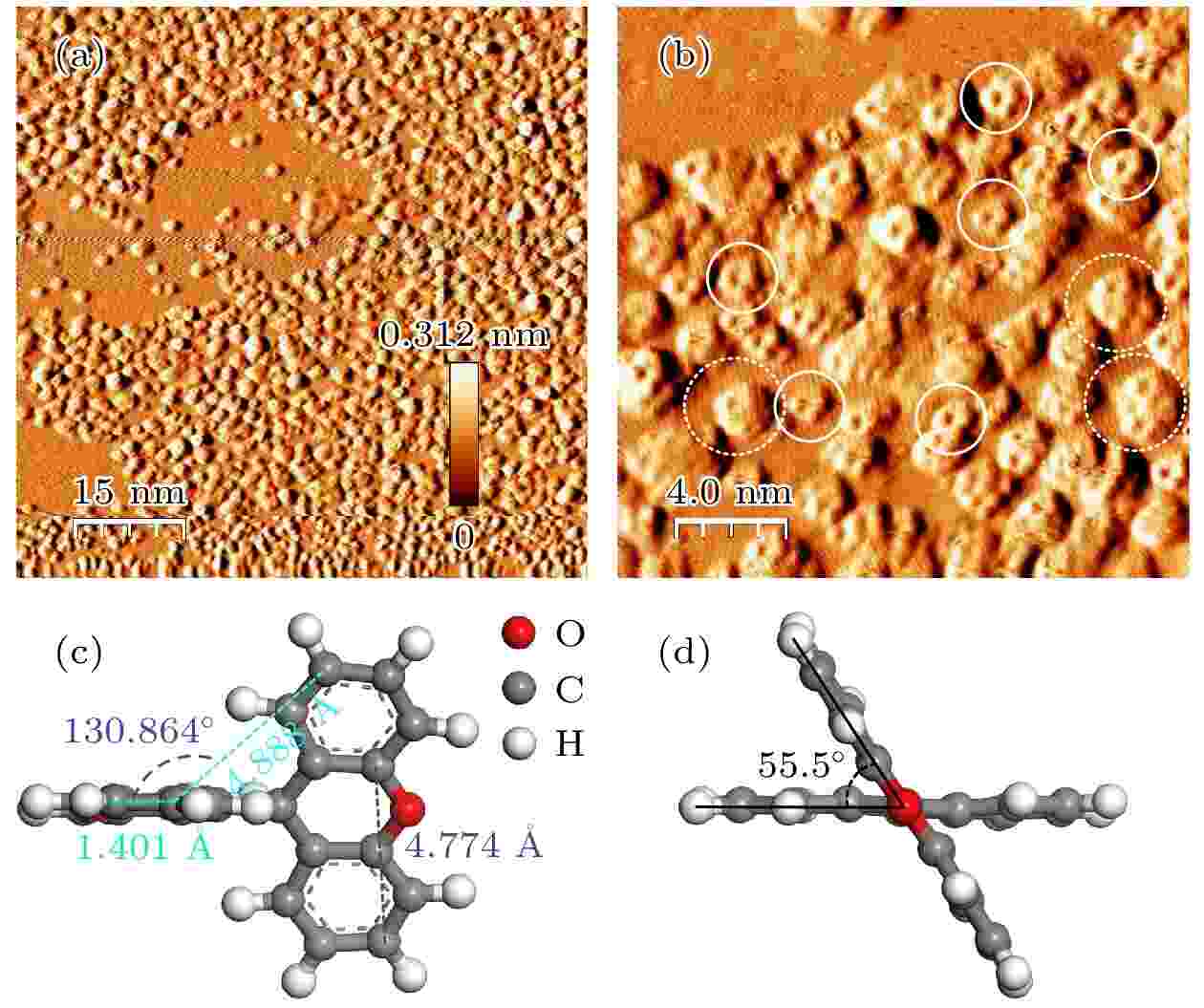
2022, 71 (21): 216801.
doi: 10.7498/aps.71.20221057
Abstract +
This paper reports the adsorption behavior of the 9,9′-Dixanthylidene on Ru(0001), the bottom-up fabrication of graphene is also investigated through a scanning tunneling microscope (STM). We analyze the spatial structure of 9,9′-Dixanthylidene molecules which are randomly dispersed on a Ru(0001) substrate in the sub-monolayer coverage. Then we bottom-up fabricate the graphene on the Ru(0001) substrate with the 9,9′-Dixanthylidene molecules as the precursor. Three kinds of moiré superstructures with different rotation angles (6.3°, 13.9°, and 16.1°) are found after implementing high temperature annealing in ultrahigh vacuum. This result provides data support for the study of moiré superstructures on Ru(0001) substrate and lays a solid foundation for further scientific research based on graphene/Ru(0001).
CONDENSED MATTER: ELECTRONIC STRUCTURE, ELECTRICAL, MAGNETIC, AND OPTICAL PROPERTIES
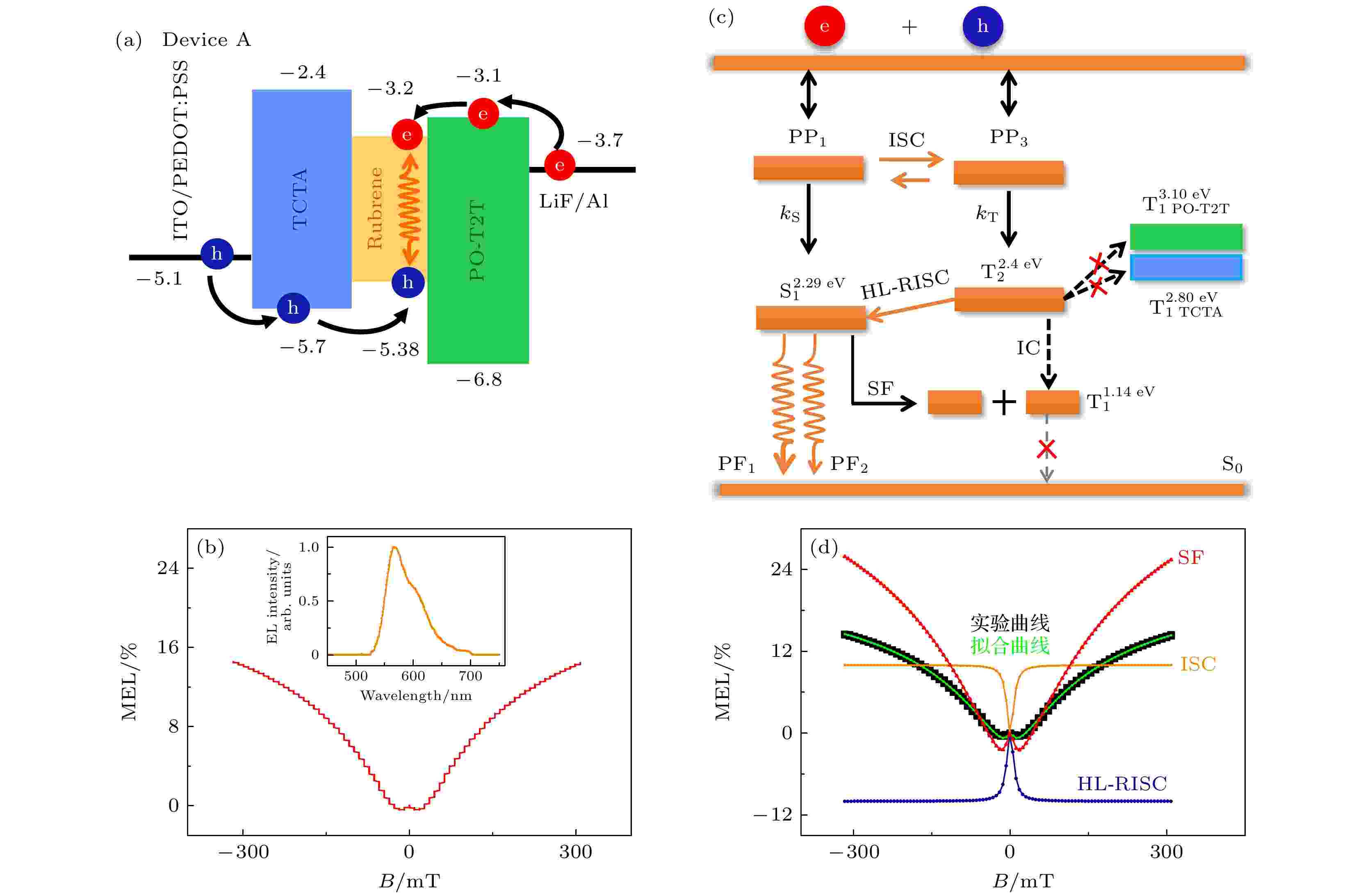
2022, 71 (21): 217201.
doi: 10.7498/aps.71.20221060
Abstract +
With unique advantages of high sensitivity, no-contact, and non-destructiveness, magneto-electroluminescence (MEL) is usually employed as an effective detection tool to visualize the microscopic mechanisms of excited states existing in organic light-emitting diodes (OLEDs) because their evolution channels of many spin-pair states in OLEDs have the fingerprint MEL line-shapes even with opposite signs. The recently-published MEL results (Tang X T, Pan R H, Zhao X, Jia W Y, Wang Y, Ma C H 2020 Adv. Funct. Mater. 5 765) have demonstrated the existence of high-level reverse intersystem crossing process (HL-RISC, S1,Rub ← T2,Rub) of high-lying triplet excitons (T2,Rub) in Rubrene when Rubrene with a typical value of several percent in content is doped into a host with high triplet exciton energy and there are no energy loss channels of triplet excitons from charge-carrier transporting layers either. Furthermore, this HL-RISC process can considerably increase the efficiency and brightness of OLEDs operated at room temperature, for example, high external quantum efficiency up to 16.1% and ten thousands of brightness have been achieved in Rubrene-doped OLEDs with a co-host of exciplex. Herein, surprisingly, in the pure Rubrene-based OLEDs (i.e. the pure Rubrene film is used as an emissive layer) with no energy loss channels of triplet excitons from charge-carrier transporting layers, only strong singlet fission (S1,Rub+S0,Rub → T1,Rub+T1,Rub) processes are detected at room temperature, but this HL-RISC process is not observed. Moreover, even the most usual evolution process of intersystem crossing of polaron-pair (ISC, PP1 → PP3) cannot be observed in this pure Rubrene-based OLEDs, where the polaron-pair is generated through the recombination of the injected electrons and holes in the pure Rubrene emissive layer. To determine the cause of the underlying physical mechanism behind this abnormal and fascinating experimental phenomena, two kinds of devices with pure Rubrene and 5% Rubrene-dopant as emissive layers are fabricated and their current- and temperature- dependent MEL responses are systematically investigated. By comparing and analyzing these tremendously different MEL curves of these two types of devices, we find that the positive Lorentzian MEL curves induced from B-mediated ISC of polaron-pair just completely cancel out the negative Lorentzian MEL curves induced from B-mediated HL-RISC process of T2,Rub excitons. Note that such an abnormal and coincidental experimental phenomenon is the physical reason why the ISC process and HL-RISC process cannot be observed simultaneously in the pure Rubrene-based OLEDs, and this phenomenon has not been found in the literature. Clearly, this work further deepeneds our understanding of some unique microscopic processes and physical phenomena in organic semiconductor “star” material of Rubrene (such as the energy resonance between 2T1 and S1 and the energy approach between T2 and S1).
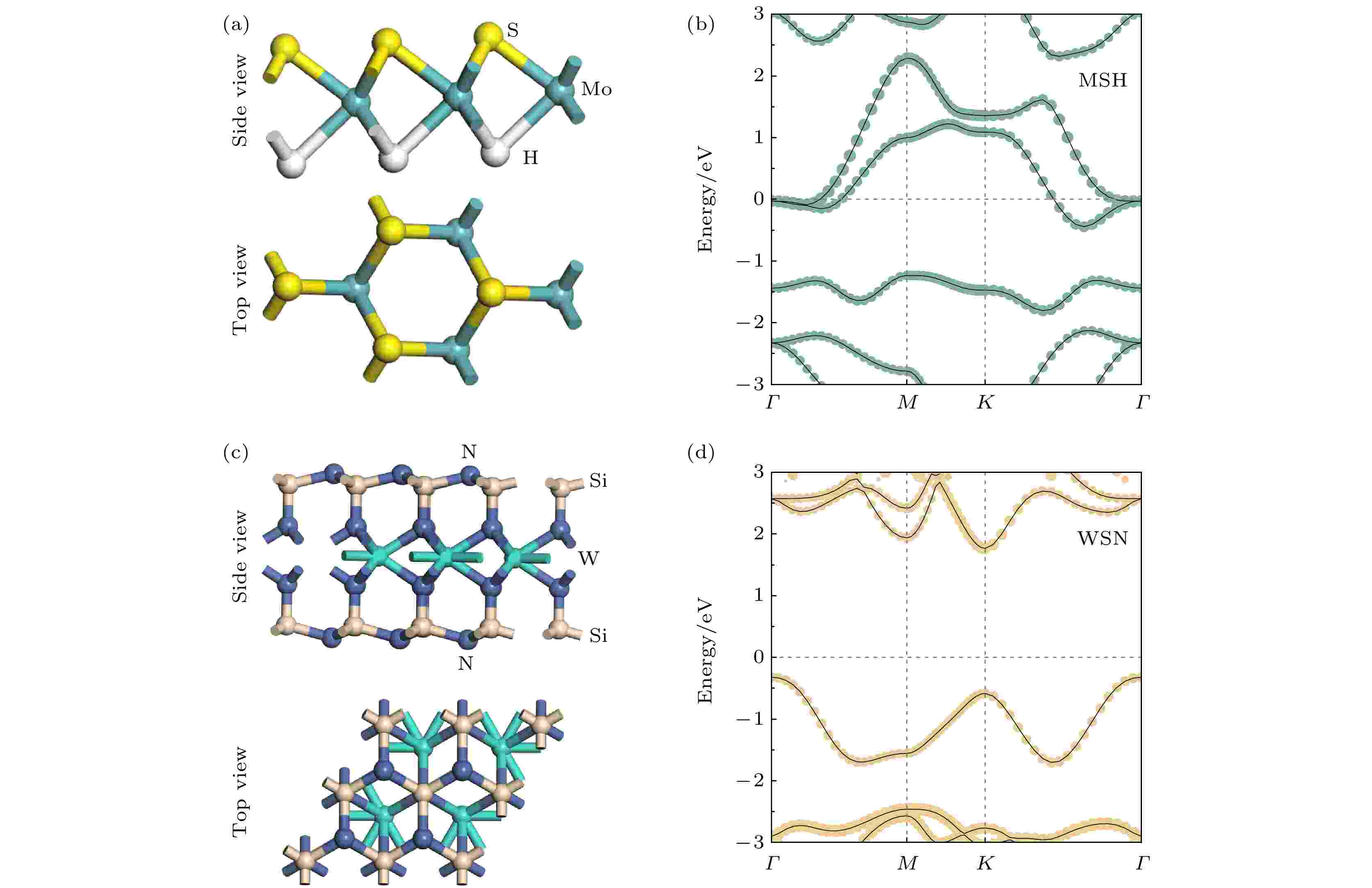
2022, 71 (21): 217301.
doi: 10.7498/aps.71.20220882
Abstract +
In view of the newly synthesized two-dimensional (2D) semiconductor material WSi2N4 (WSN) and the 2D metal material MoSH (MSH), a metal-semiconductor MSH/WSN Schottky-junction is constructed in this work. In practical applications of metal-semiconductor contact, the presence of the Schottky barrier degrades the device performance severely. Therefore, it is crucial to obtain a smaller Schottky barrier height or even an Ohmic contact. Here, the first-principles calculations are used to investigate the variation of the Schottky barrier in MSH/WSN Schottky-junction under an external electric field and a biaxial strain. The results show that both external electric field and biaxial strain can effectively modulate the Schottky barrier of the MSH/WSN Schottky-junction. The dynamic switching between the p-type Schottky contact and the n-type Schottky contact can be achieved under the action of positive external electric field in the MSH/WSN Schottky-junction. Under the action of negative external electric field, the MSH/WSN Schottky-junction can be modulated to realize the transition from the Schottky contact to the Ohmic contact. The large biaxial strain can also induce the MSH/WSN Schottky-junction to realize the transition between the p-type Schottky contact and the n-type Schottky contact. This work may provide theoretical guidance for the WSN semiconductor based Schottky functional devices and field-effect transistors.
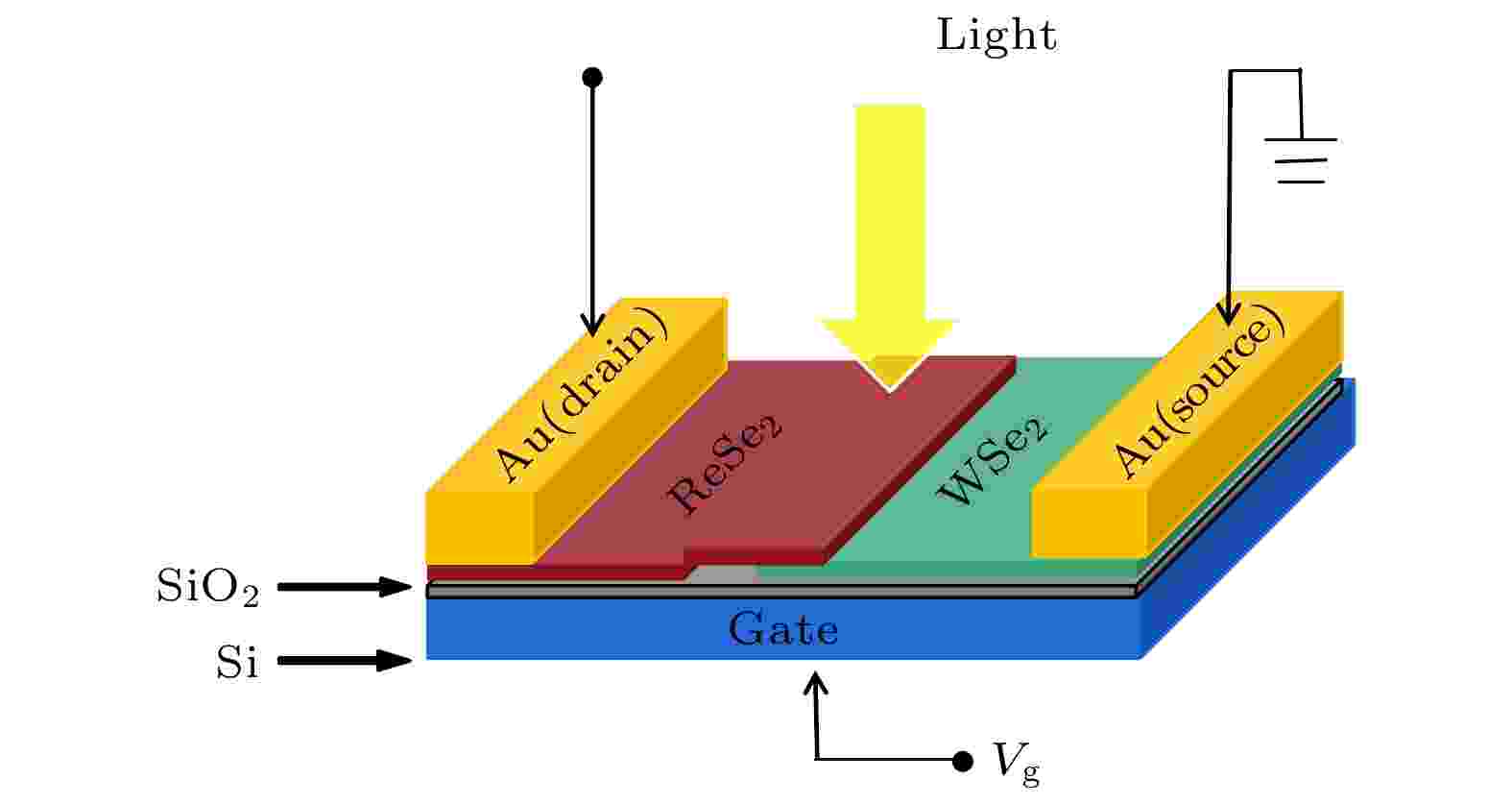
2022, 71 (21): 217302.
doi: 10.7498/aps.71.20221154
Abstract +
Memtransistor is a multiterminal device combining the concepts of memristor and field-effect transistor. Two-dimensional transition metal sulfides have unique electronic structure and properties, and they are widely used in electronic devices, energy conversions, memories and other fields. In this work, a two-dimensional ReSe2/WSe2 heterostructure memtransistor is prepared, then the resistive switching characteristics under the electrical modulation, optical modulation, and electric-optical dual gate control are discussed. The results show that the gate control is an effective modulation method, which can change the on/off ratio of the device from 101 to 105. Then, the resistance and on/off ratio of the memtransistor can be controlled by changing the light wavelength and the illumination power. Moreover, the switching ratio of the device can also be changed in a range of 102–105 by electric and light dual-gate control, and the reasons for the change of resistance states of the device under different modulation conditions are analyzed. Furthermore, after 225 cycles and 1.9 × 104 s, the ReSe2/WSe2 heterostructure memtransistor still maintains a switch ratio close to 104, indicating the good stability and durability of the device. It demonstrates that the ReSe2/WSe2 memtransistor will be one of potential candidates for the next- generation nonvolatile memory applications.
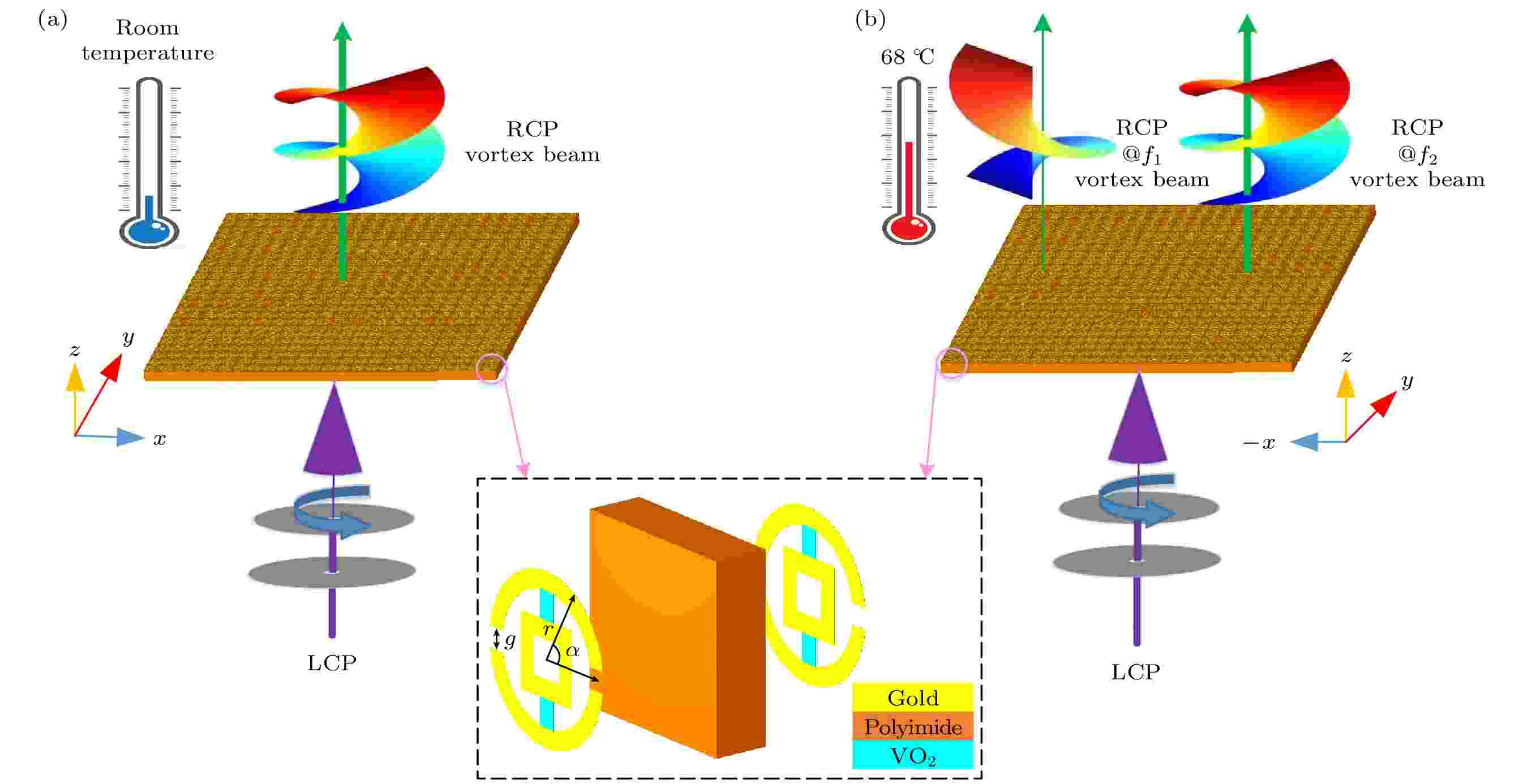
2022, 71 (21): 217401.
doi: 10.7498/aps.71.20221184
Abstract +
Most of the reported vortex beam generators generate vortex beams at a fixed frequency, which limits the practical applications. Therefore, it is inevitable to explore a vortex beam generator, which can actively control the operating frequency. We propose a switchable frequency terahertz vortex beam metasurface, it is freely switchable under single-frequency mode and dual-frequency mode by changing the external temperature, the phase state of vanadium dioxide (VO2) is also changeable. External temperature changes will cause VO2 to transform from insulating state to metallic state. Generally, VO2 conductivity can increase by several orders of magnitude as operating temperature changes. By using the phase change property of VO2, we can obtain a metasurface with switchable operating frequencies. For operating at room temperature, the proposed metasurface behaves as a single-frequency terahertz vortex generator. When (left-handed circularly polarized, LCP) terahertz wave is vertically incident on the metasurface, it generates vortex beams with different topological charge numbers at a frequency of 1.1 THz, and the mode purity is above 85%. The simulation results show that the mode purity of the vortex beam with the topological charge l = 1 is 90%, and the mode purity is about 91.1% for the vortex beam with l = 2, and 85.4% for the vortex beam with l = 3. When the external temperature is of 68 ℃, the designed metasurface becomes a dual-frequency vortex beam generator. At this time, the operating frequencies of vortex beams with different topological charges (l = 1, 2, 3) are 0.7 and 1.23 THz, whose mode purities are both above 60%. That is to say, the corresponding mode purities at topological charge with l = 1 for two operating frequencies are 89.1% and 71.6%, respectively. The mode purities are 83.2% and 94.4% with topological charge l = 2, respectively. The mode purities are 62.4% and 68.2% with topological charge l = 3, respectively. Therefore, the proposed switchable frequency terahertz vortex generator provides a new design idea for working frequency modulation in wireless terahertz communication.

2022, 71 (21): 217501.
doi: 10.7498/aps.71.20220472
Abstract +
As one of the most representative features characterizing the spin valve structure, magnetoresistance is an important method to study the interlayer coupling in multilayers. Considering the induced magnetism of rare earth at room temperature due to the coupling and magnetic proximity effect in the structure of rare earth/magnetic transition metal, an intermediate nonmagnetic metal can be inserted to form the spin valve structure to regulate the interlayer coupling, which expands the scope of applications of rare earth in spintronics. In this work, the interlayer exchange coupling and interfacial effects of Gd (4 nm)/Cr (tCr)/FeCo (5 nm) trilayers with different Cr layer thickness (tCr) are studied by means of in plane magnetoresistance. Compared with FeCo film, Gd/FeCo film obtains more obvious anisotropic magnetoresistance. While the magnetoresistance value obtained for the configuration of I⊥H shows a minimum value at the peak due to the insertion of Cr layer, and this minimum value becomes more pronounced with the increase of tCr. When tCr = 3 nm, the negative spin valve effect almost totally overcomes the anisotropic-magnetoresistance effect. Different spin asymmetries of scattering that are formed in FeCo layer and Cr/Gd layers are mainly responsible for creating the negative spin valve magnetoresistance, in which the resistance becomes smaller near the coercive, while the resistance becomes larger at high field parallel to magnetic moment. The oscillation of magnetoresistance with tCr at I // H and the hysteresis loops at 5 K further confirm the existence of interlayer coupling both at room temperature and 5 K.
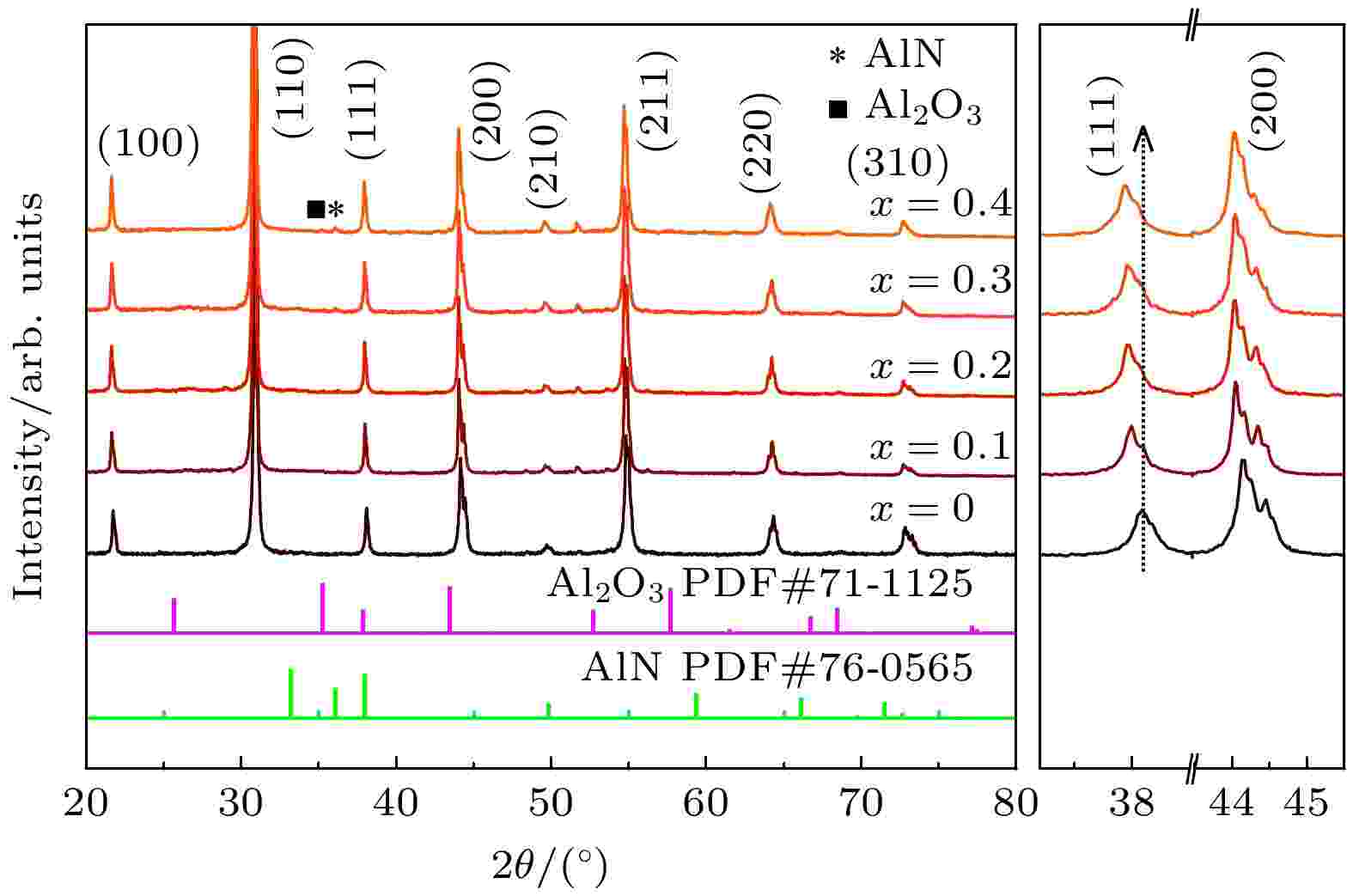
EDITOR'S SUGGESTION
2022, 71 (21): 217701.
doi: 10.7498/aps.71.20221250
Abstract +
In this work, composite ceramics (1–x)Pb0.99Nb0.02[(Zr0.57Sn0.43)0.94Ti0.06]0.98O3:xAlN (abbreviated (1–x)PNZST:xAlN, x = 0, 0.1, 0.2, 0.3 and 0.4) are prepared by a two-step solid phase synthesis method. The crystal structures, micromorphologies, domain structure evolutions, ferroelectric, dielectric and pyroelectric properties of those composite ceramics are systematically investigated. The results show that the difference in thermal expansion coefficient between PNZST and AlN creates compressive stresses in the PNZST matrix when cooling down from the sintering temperature, then a metastable ferroelectric (FE) phase is induced in the anti-FE matrix by the AlN component-induced internal stress, and in turn ferroelectric/antiferroelectric phase boundary is constructed near room temperature. As the temperature increases, the ferroelectric-to-antiferroelectric phase transition causes a larger pyroelectric current peak. In particular, the composition with x = 0.1 exhibits a high pyroelectric coefficient p = 3.3×10–3 C⋅m–2⋅K–1 and figure-of-merit with current responsivity Fi = 3.16×10–9 m⋅V–1, voltage responsivity Fv = 0.613 m2⋅C–1, and detectivity Fd = 4.4×10–4 Pa–1/2 around human body temperature. Moreover, the enhanced pyroelectric coefficient exists in a broad operation temperature range with a large full width at half maximums of 16.3 ℃ at 37 ℃. With the increase of AlN content, the pyroelectric peak temperature of the composite ceramic is adjustable in a wide temperature range of 37–73 ℃, showing good temperature stability.
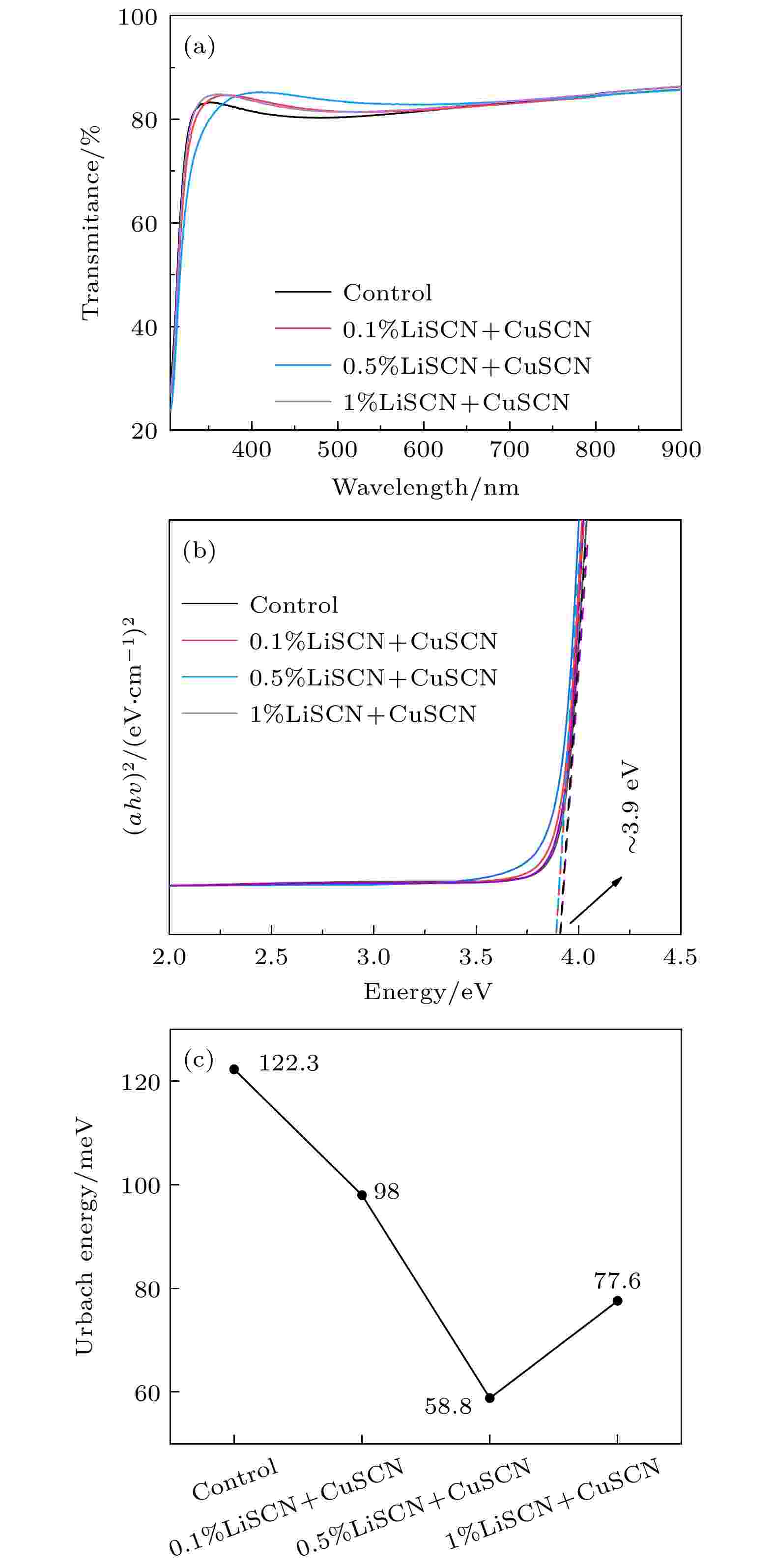
EDITOR'S SUGGESTION
2022, 71 (21): 217801.
doi: 10.7498/aps.71.20221222
Abstract +
Perovskite solar cells have attracted extensive attention because of their photoelectric characteristics. Since 2009, the photoelectric conversion rate of the solar cells has soared from 3.8% to 25.7%. Perovskite material has become a focus of extensive academic research due to its advantages of high carrier mobility, low exciton binding energy, wide absorption spectrum and high optical absorption coefficient. However, organic P-type semiconductor material is usually used as a hole transport layer in high efficiency perovskite solar cells, for example, Spiro-OMeTAD, PEDOT:PSS, and PTAA. Because Spiro-OMeTAD is difficult to purify, many hole transport materials containing triphenylamine like Spiro-OMeTAD have been synthesized, such as triphenylamine polymer PTAA. As the conjugate parts of these triphenylamine transport materials are not coplanar and the space is distorted, they cannot form ordered stacks by spin-coating method, so their charge properties are weak, and li-TFSI and tBP are often added to improve the hole transport, so as to achieve better device effects. Moreover, the PTAA has the problem of infiltration, and it is difficult to form a completely covered perovskite film on it, which seriously affects the quality and surface morphology of perovskite film. The PEDOT:PSS itself has an acidic and corrosive electrode, and is easy to absorb moisture, which will affect the stability of the solar cell. The performance of organic material will deteriorate seriously under environmental factors such as humidity, temperature and UV irradiation, which will accelerate the aging of perovskite solar cells and become one of the main obstacles to their practical applications. In this work, the inorganic cuprous thiocyanate (CuSCN) is used as a hole transport material, the CuSCN is a rich and stable P-type semiconductor material, which has the characteristics of abundance, low cost, high carrier mobility, appropriate energy level, low defect density, good thermal stability, and excellent light transmittance. The CuSCN is one of the few known compounds with both high optical transparency (its wide band gap is 3.7–3.9 eV) and significant P-type electrical conductivity. Most importantly, CuSCN is inexpensive and can be prepared by solution method at room temperature. And its hole transport properties are improved by lithium doping. On this basis, the surface of CuSCN is modified with PTAA to avoid the interaction between CuSCN and lead iodide (PbI2), and the large-grained and dense perovskite films are prepared. Finally, the performance of perovskite solar cells is effectively improved. This work provides a reference for the preparation of the stable and efficient perovskite solar cells.
INTERDISCIPLINARY PHYSICS AND RELATED AREAS OF SCIENCE AND TECHNOLOGY

EDITOR'S SUGGESTION
2022, 71 (21): 218102.
doi: 10.7498/aps.71.20220820
Abstract +
The AlOX tunnel barrier in Josephson junctions prepared by conventional thermal oxidation method is formed by diffusing high-purity oxygen into the surface of Al. But the tunnel barrier fabricated by this method is not completely oxidized, and the thickness of barrier is hard to control accurately. In this work, we use atomic layer deposition to grow Al2O3 tunnel barrier on the surface of Ti. The sandwich structure of Ti/Al2O3/Ti Josephson junction is grown layer by layer. We investigate the corresponding microstructure and electrical properties by adjusting the thickness of the Al2O3 tunnel barrier and the area of the junction. The experimental results show that the monolayer Al2O3 film is about 1.17 Å (1 Å = 10–10 m), which is grown by atomic layer deposition, achieves atomic-level controlled thickness. The resistance is controlled by adjusting the barrier thickness at room temperature. And we obtain a Josephson junction with good resistance uniformity at room temperature by optimizing the junction area.

EDITOR'S SUGGESTION
2022, 71 (21): 218501.
doi: 10.7498/aps.71.20220990
Abstract +
Narrowband photodetection systems are widely used in fluorescence detection, artificial vision and other fields. In order to realize the narrow spectral detection of special band, it is traditionally necessary to integrate broadband detectors with optical filters. However, with the development of detection technology, higher requirements have also been placed on the power consumption, size, and cost of the detection system, and the applications of traditional narrowband photodetectors with complex structures and high costs are limited. Thus, a filterless, narrowband near-ultraviolet photodetector based on a porous GaN/CuZnS heterojunction is demonstrated. The porous GaN thin films with low defect density and CuZnS thin films with high hole conductivity are fabricated by photoelectrochemical etching and water bath growth methods, respectively, and the porous GaN/CuZnS heterojunction near-ultraviolet photodetectors are thus fabricated. Benefiting from the porous structure of GaN and the optical filtering effect of CuZnS, the photo-dark current ratio of the device exceeds four orders of magnitudes under –2 V bias and 370 nm light illumination; more importantly, the device has an ultra-narrowband near-ultraviolet photoresponse with a full width at half maximum of <8 nm (peak at 370 nm). In addition, the peak responsivity, external quantum efficiency and specific detectivity reach 0.41 A/W, 138.6% and 9.8×1012 Jones, respectively. These excellent device performances show that the near-ultraviolet photodetectors based on porous GaN/CuZnS heterojunctions have broad application prospects in the field of narrow-spectrum ultraviolet photodetection.
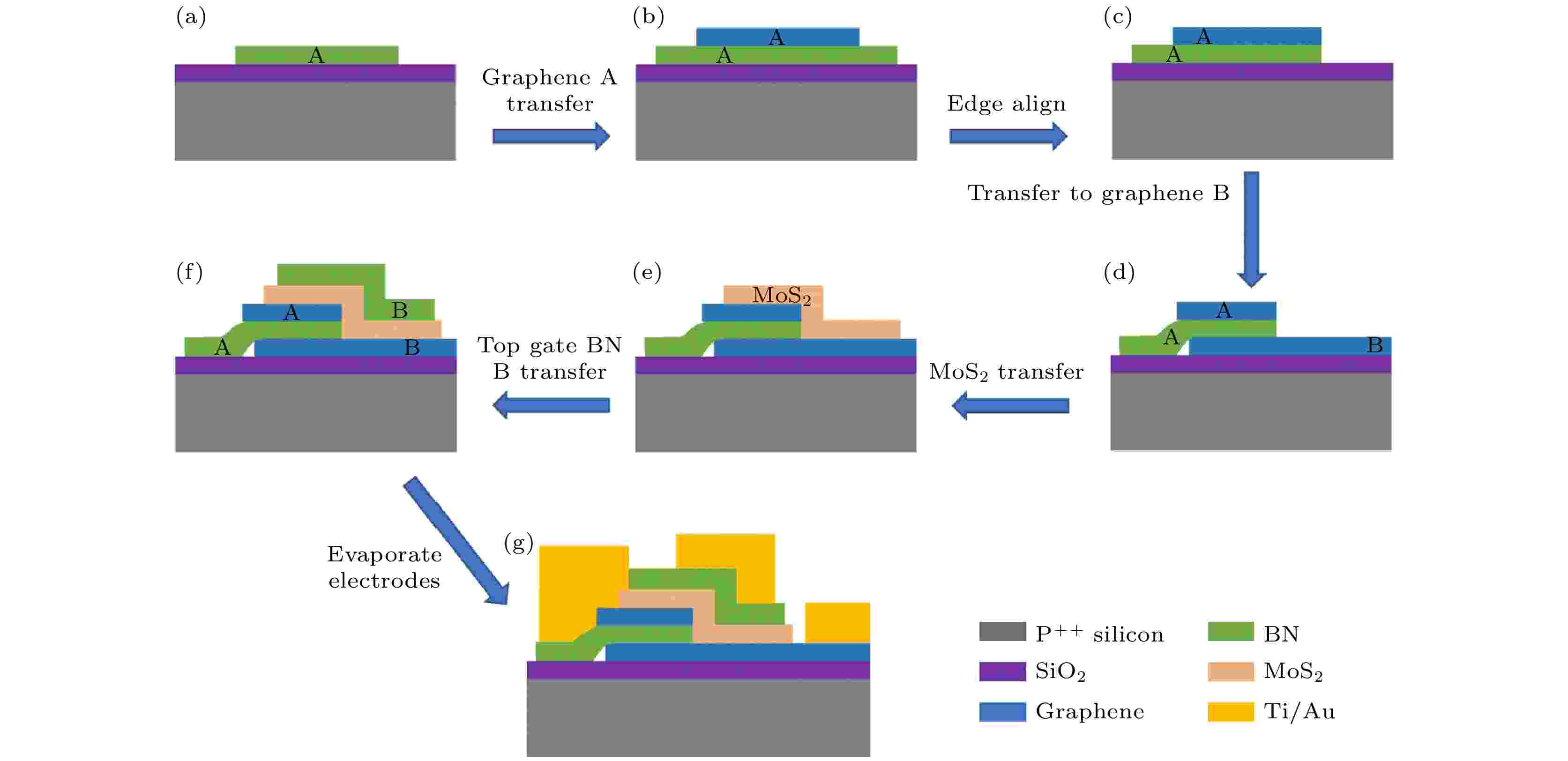
COVER ARTICLE
2022, 71 (21): 218502.
doi: 10.7498/aps.71.20220738
Abstract +
Field effect transistors (FETs) based on two-dimensional (2D) materials have great potential applications in very large-scale integration technology, and high-performance short channel 2D semiconductor FETs are essential. Owing to the difficulty in obtaining channel lengths below 10 nm for 2D materials, there are few stable methods of fabricating short channel 2D semiconductor FETs. Here we report a method of stably fabricating vertical short-channel MoS2 FETs by using graphene as the contact material and h-BN as the spacer. The 8-nm spacer transistor exhibits good switching characteristics. The on/off ratio is greater than 107 and the off-state current is less than 100 fA/μm under different source-drain voltages, which are immune well to the direct source-to-drain tunneling effect. This method can be used to rapidly screen two-dimensional materials that are immune to short-channel effects and also are suitable for the fabrication of high-performance FETs.
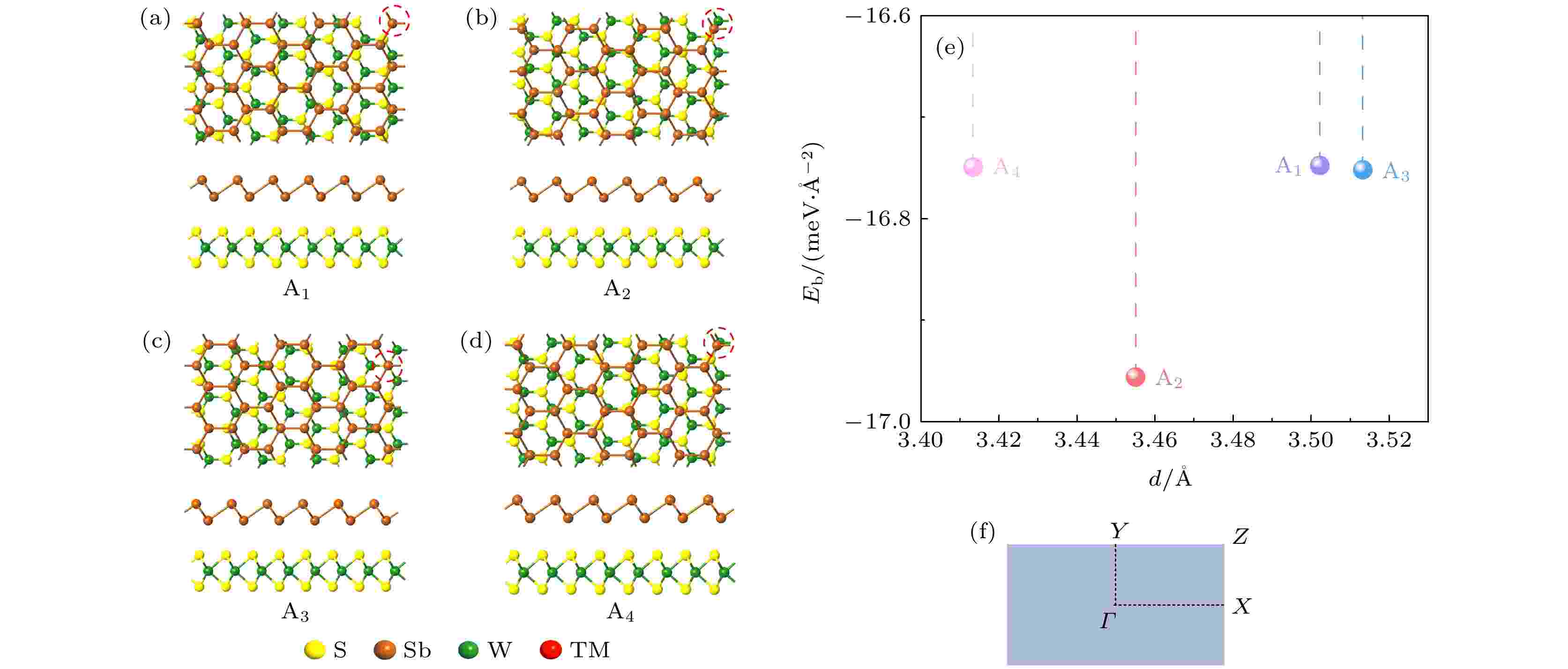
2022, 71 (21): 218503.
doi: 10.7498/aps.71.20220949
Abstract +
To study the induced magnetism mechanism and magneto-electronic properties of non-magnetic two-dimensional van der Waals heterostructure adsorbing magnetic atoms, we construct Sb/WS2 heterostructure, and consider its adsorbed Fe atoms. The calculated adsorption energy shows that TW, VSb adsorption are the most likely positions for Fe atom adsorbed below and above the heterostructure, respectively, and TS_M adsorption is the most likely position for Fe atom adsorbed between two monolayers. The induced magnetism is due to the electron-spin rearrangement caused by the expansion of valence electronic configuration (VEC) and charge transfer after Fe atoms have been adsorbed. The TW adsorption and the TS_M adsorption make the nonmagnetic semiconducting heterostructure become a half-semiconductor (HSC), while VSb adsorption turns the heterostructure into a bipolar magnetic semiconductor (BMS). In particular, the calculated magnetized energy indicates that the interlayer TS_M adsorption leads the heterostructure to holding the highest magnetic stability, which is enough to resist the influence of thermal fluctuation at room temperature. Quantum manipulation can cause the heterostructure to produce abundant magnetism, especially the flexible change of magnetic phase. For example, the application of external electric field can give rise to the magnetic phase transition among HSC, HM (half-metal) and BMS for the heterostructure, and the vertical strain can make the heterostructure realize the magnetic phase transition among HSC, HM and MM (magnetic metal). This study shows that the heterostructure can increase the adsorption region of transition metal atoms (below, interlayer and above), so as to produce rich magnetism, especially for the interlayer adsorption of transition metals, its magnetic stability against temperature is significantly enhanced.
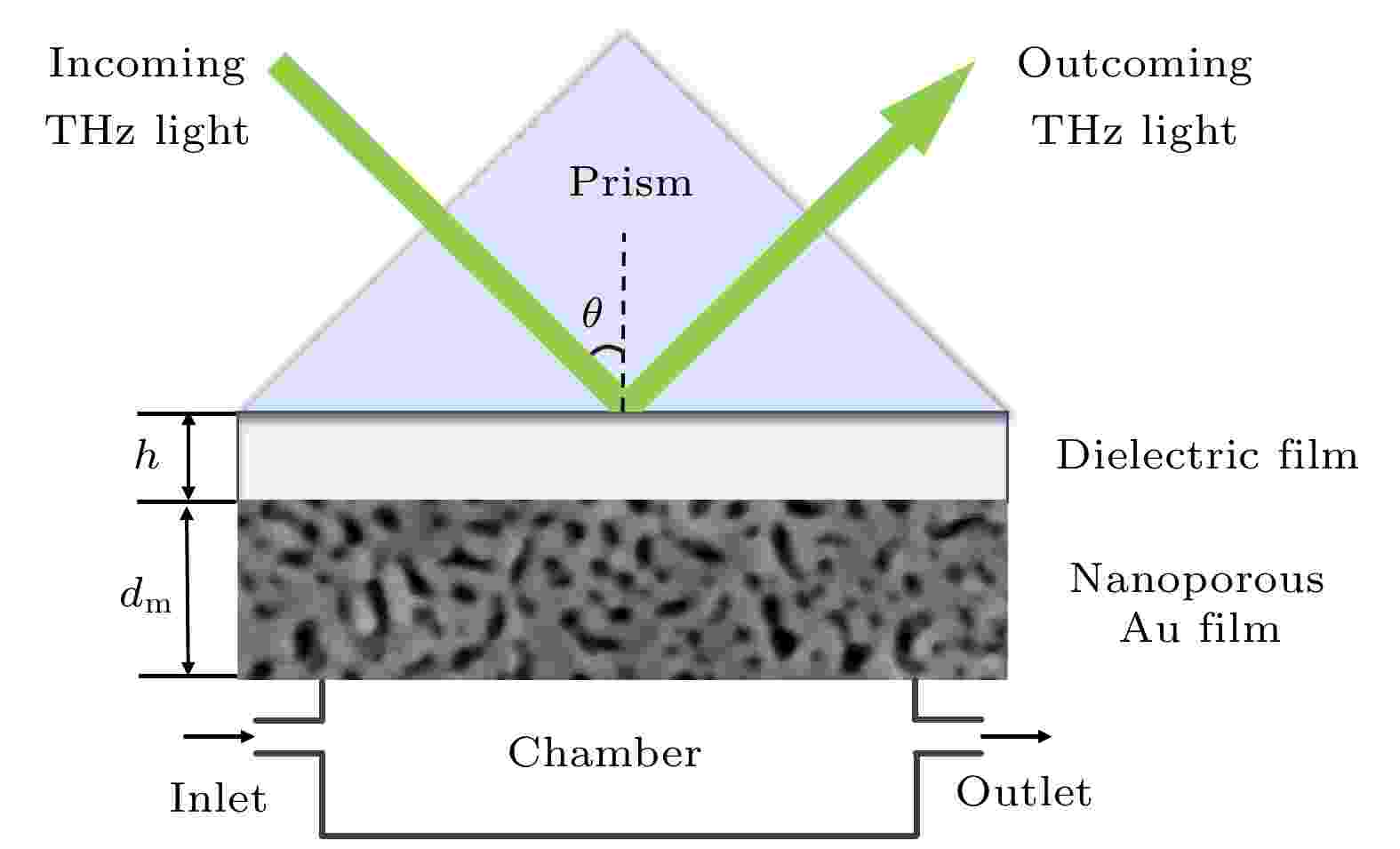
EDITOR'S SUGGESTION
2022, 71 (21): 218701.
doi: 10.7498/aps.71.20220722
Abstract +
A highly sensitive terahertz (THz) waveguide resonance biochemical sensor is designed and simulated. The sensor consists of a silicon prism, a dielectric layer and a nanoporous gold film. The nanoporous gold film acts as both a THz waveguiding layer and a biochemical molecular enrichment layer, which can enhance the interaction between the THz waveguide mode and the adsorbed biochemical molecules, consequently improving the sensor’s sensitivity. When the THz transverse electric (TE) or transverse magnetic (TM) modes are excited by the prism-coupling method, the THz absorption of the nanoporous gold film results in the sharp resonance dips in the THz reflection spectrum. The resonance frequencies of the THz waveguide modes and the sensitivity to either liquid refractive index (RI) or adsorbed molecules can be determined with the measured reflection spectra, and the sensor’s sensitivity and its figure of merit (FOM) can be improved by adjusting the thickness and RI of the dielectric layer. The simulation results at 45º incidence angle indicate that the resonance frequencies of the TE and TM modes of the sensor linearly change with increasing either liquid RI or the amount of adsorbed molecules, and the RI sensitivity and the FOM with the TM mode are 13.42 THz/RIU and 167.70/RIU, respectively. Compared with the TM mode, the TE mode has a lower sensitivity to lqiuid RI but a high sensitivity to adsorbed molecules. The reason for these differences is that with the TE mode the evanescent field penentrating out of the nanopous gold film is weaker than that with the TM mode.
GEOPHYSICS, ASTRONOMY, AND ASTROPHYSICS
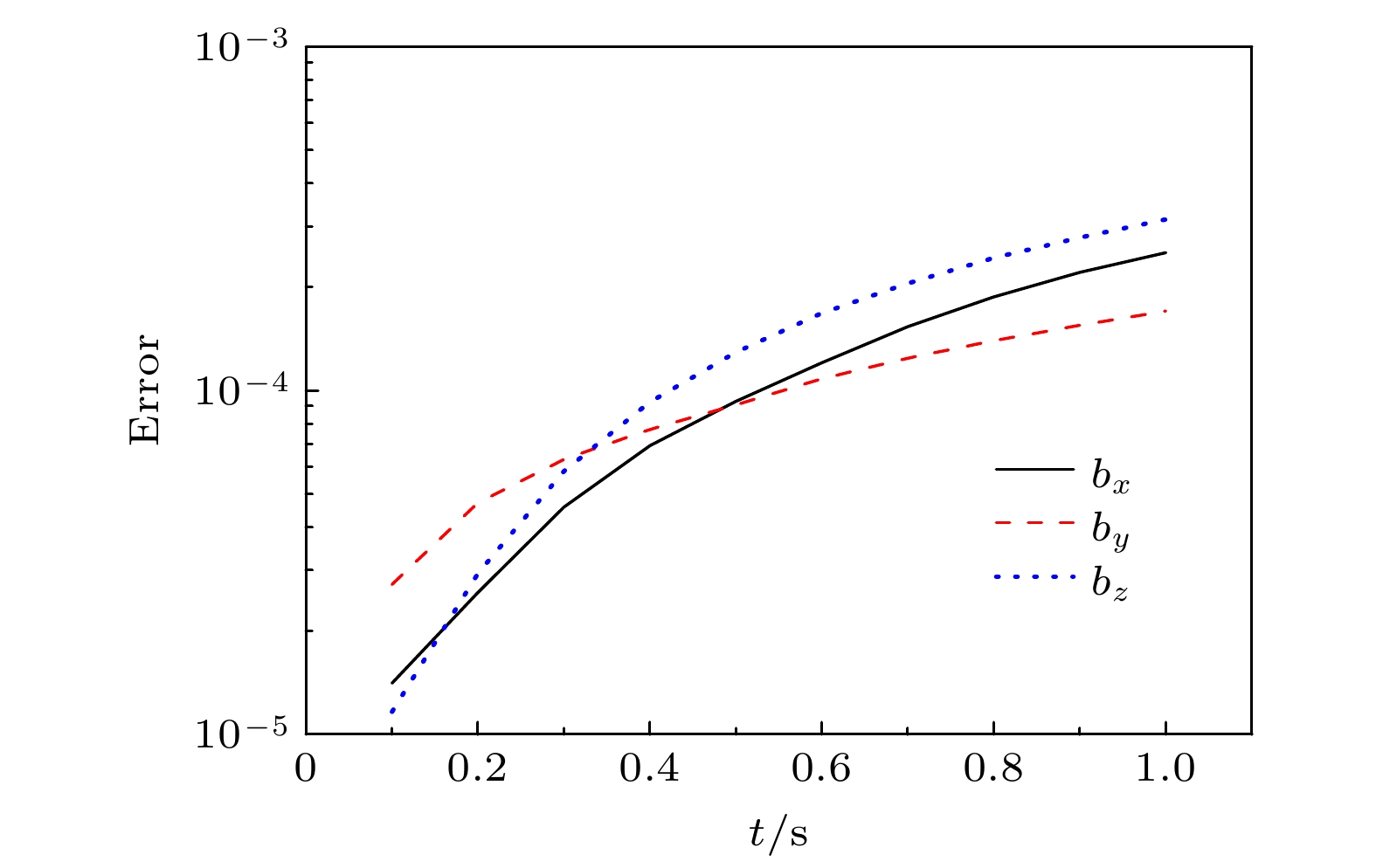
2022, 71 (21): 219401.
doi: 10.7498/aps.71.20220732
Abstract +
In this work, a three-dimensional hybrid simulation program is used to investigate the process of the explosion and expansion of a large number of thermal debris ions in a low density background plasma. By quantitatively calculating the variation of the magnetic bubble and the bubble constraint in the motion of the debris cloud, studied are the influences of the background plasma charge density, the background ion atomic weight, and the charge-mass ratio of the fragment ion on the magnetic bubble. The results show that the background charge density has an important effect on the motion of the bubble and debris cloud. In the early stage of the debris cloud expansion, the background ion atomic weight has little effect on the bubble expansion, but it affects the movement of debris cloud at a later time. When the charge-mass ratio of the debris ion is small, the radius of the ion gyration is larger than the bubble radius, and the bubble radius is small so that it cannot restrain the debris cloud. When the charge-mass ratio of the debris ion is large, the radius of the ion gyration is smaller than the bubble radius. If the background charge density is low in this condition, the early expansion of the bubble and the debris cloud are slightly affected by the charge-mass ratio of the fragment ions, and only the subsequent evolution of the system is influenced. If the background charge density is large in this condition, the charge-mass ratio of the fragment ion has a prominent influence on the motion of the bubble and the debris cloud.



















